#but also examining how they get worked back into society's ideas about gender expectations by serving as an example for others
Note
Hey if you don’t mind sharing what’s the name of the t Muir short story where the woman kills a dragon and she and her love interest go into business together as professional monsters? It sounds great!
it's called princess floralinda and the forty-flight tower! I recommend it
#i didn't enjoy the narrator voice as much as in many of her other works but i think the themes she's engaging with are really interesting#kind of asking what makes a thing monstrous/in what ways is gender non-conformity enough to make a person an outcast#but also examining how they get worked back into society's ideas about gender expectations by serving as an example for others#it's good stuff!#for fans of women getting bloody & messy there is much to appreciate here#replies
30 notes
·
View notes
Text
Steven Universe: End of an Era: Outline & Review
I wrote this review in October but never got around to posting it here
Steven Universe: End of an Era is far more than an art book–it’s also a collection of behind-the-scenes material, stories about the experience of working on the show, planning documents and associated background info, and both older versions of developed concepts AND concepts that never made it into the show. It's a huge fusion of all those elements, and it's definitely an experience!
Some low-quality images are included with my review just to give you an idea of what’s there--it’s not a good substitute for getting your own copy, but here’s a tour!
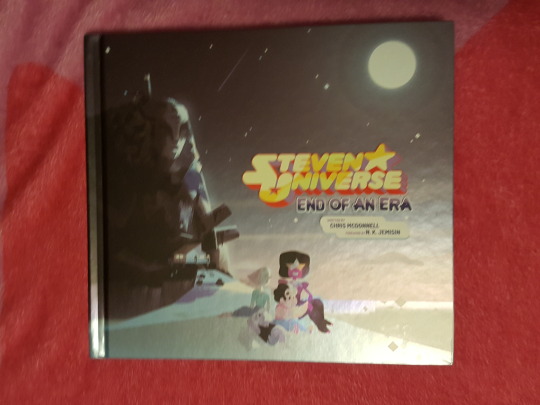
Like the previous concept art book, Art and Origins, I'll be giving you a description of the structure and overview, while also collecting notable information for fans. Obviously just about everything is "notable" once again, but I'll aim for unique insight or perspective on the main source material, keeping the screaming about everything new to a minimum so you can also enjoy something for yourself if you pick it up. My low-quality photos should prevent people from feeling like I'm reproducing the book in any capacity. Please grab one while you can and have your own experience!
[SU Book and Comic Reviews]
OVERVIEW
The book is titled "End of an Era" for a couple reasons--obviously because it is released after the show has wrapped, but also because Gem history recently ended its "Era 2" and began Era 3--an age of prosperity and peace. The author--the person in charge of adapting all of this information into this slick, readable package--is Chris McDonnell, whose work was previously applied on the Art and Origins book.
The foreword is by N.K. Jemisin, a well-known science fiction author who's a huge fan of the show (and wrote a really excellent series that also has a weird geological connection, by the way).
And the cover, like its predecessor, is shiny and decorated with a beach scene featuring minimalistic characters--this time it's the Gems at night in front of the Temple, and on the back cover is a big pink leg ship in a cross-legged pose.
The interior covers are decorated with tons of amazing sketches of Steven and Connie on the front, and a bunch of Gem sketches on the back. Every interior page that most would leave blank is highlighted with some kind of sketch art or character exercise--it's so much to look at, so much to absorb.
The book is dedicated "For Eddie."
Its organization is different from the previous book in that it shares applicable work in chunks associated with groups of episodes rather than pertaining to different aspects of building the show.
FOREWORD
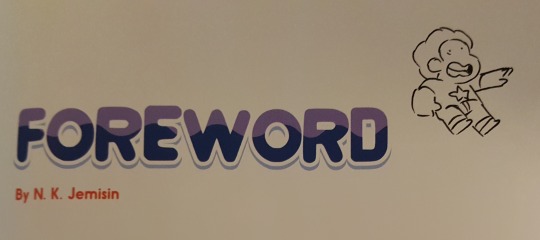
N.K. Jemisin gives us such a great introduction to the book--apparently understanding very well that the audience of this book is full of animation enthusiasts and adult fans more than it is full of kids, and explaining that bewildering journey some adults had from blowing this show off as a silly kid thing to falling in love with it hard and fast.
The important thing, Jemisin says, is being able to trust a storyteller with your heart. And it was clear to her that Rebecca Sugar knew what she was talking about and was saying important things about identity and the radical power that comes with accepting it and demanding respect.
Important also is how we handle heroes and who gets to be one in fantasy. That's part of the reason Steven Universe speaks to so many--because we see ourselves here, and know stories can be about us. Acknowledging the power we all have to MAKE THINGS BETTER with what we fight for is so important--especially if we're going to speaking to the next generation about it.
Highlighting Rose Quartz as a "born leader" who failed and Steven as a relatable scamp who did what she couldn't, Jemisin asserts that we can save the world.
1. END OF AN ERA
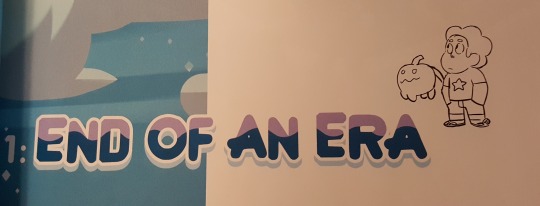
We start with an appeal to the audience to think about identity and the formative parts of our childhood--and how different it is if who you are and who you become is restricted, mocked, erased, or Not Allowed. Most people, if not ALL people, can relate to this, but for those of us with a special relationship with Steven Universe because of queer identity, this hits hard.
But it doesn't have to be anything grand to be something we respect--this show's authenticity comes largely from how personal everything is, drawn from real-life experiences and incidental truths from each artist's perspective, leaning hard on childhood and formative experiences.
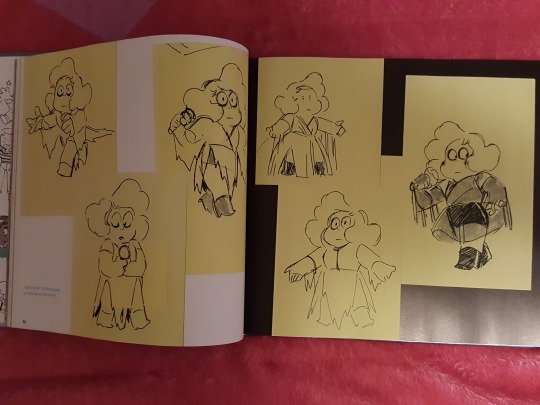
Rebecca Sugar offers some interview bits to discuss writing philosophy and why "writing female characters" was difficult for a nonbinary person who'd been socialized as a girl and a woman. Rebecca has spoken before about how frustrating it is that marketing for cartoons was SO gendered when she was growing up (and to some extent still is).
The Gems in the story are all "she/her," but on their planet they're defined by their work, not by emotion or relationships (unlike women in our society), so having them be socialized opposite to how she was and be able to claim those emotions through choice and NOT as just an expectation "as women" was revolutionary. Rebecca wants her show to tell all marginalized people that they don't deserve to be in the margins.

Weighing in on other aspects of the show were Ian Jones-Quartey, Joe Johnston, and Miki Brewster. Ian describes feeling like at first doing SU was a thrill ride that meant they'd finally get to do all the cool stuff, but it quickly became a responsibility that he took very seriously--the need to tell a good story now that he'd been given a megaphone.
Promotional art, planning documents, character sketches, and concept art from the lighthearted to the stone serious is included, along with some very cool (sort of famous) timeline charts that track major characters' developments. It's emphasized by Rebecca that the developmental materials ARE NOT CANON (and especially are not MORE canon) compared the final show.

There are concept sketches alongside final art for Aquamarine and Topaz in "Wanted" (with Topaz labeled "Imperial Topaz"), the Zircons in "The Trial," Blue and Yellow Diamond, and the Off Colors (including Pink Lars).
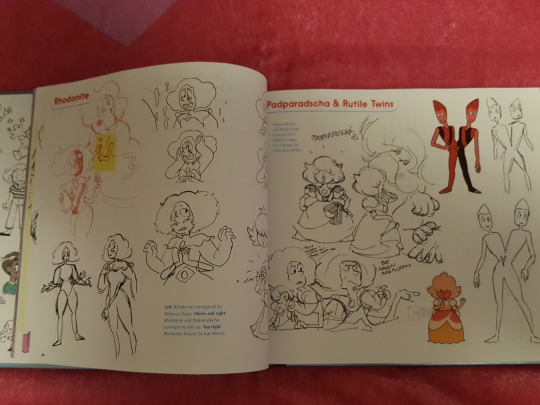
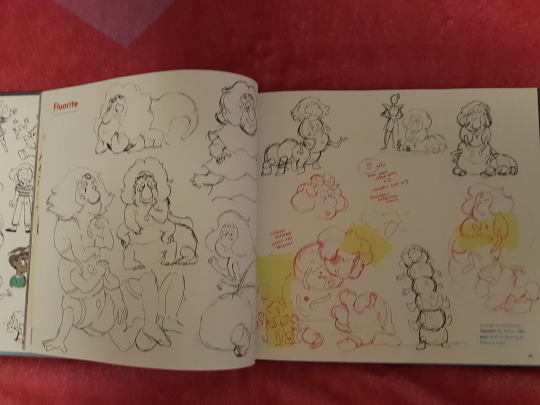
And there's also a spread of "the two sides of Steven's life: Gem Magic and Rock N Roll" featuring Sadie Killer and the Suspects (referred to as "Buck's band")--as well as a cool "Crew Cameos" key and some concepts for short-haired Connie.
And then there's some more "finished" art with stills alongside concepts, including some background art, revision, and really cool "fairytale" art from some of the shadowplay storytelling bits. We get "Lars of the Stars," "Jungle Moon," and "Can't Go Back."
2. THE BEGINNING OF THE END: A SINGLE PALE ROSE

In discussing the huge reveals and Gem mysteries in the show, the pacing is examined, and emphasis is put on the intended "slow burn." One of the most difficult things in the show was to strategize so that every piece that was needed to support another piece in the future was placed properly to seed what it was supposed to.
Some of the ideas they developed were more of a group effort and were fit together collaboratively (like Amethyst's being younger than the other Gems and Jasper being from Earth), while others were intended from the beginning based on Rebecca's vision (the fundamental idea of Pink Diamond's true identity, for instance, as well as Obsidian's design and sword and our Pearl not being Pink's first).

The writing process gets a great deep dive here, including fun tidbits like how the orb in the moon base was inserted by Joe Johnston and they literally had no idea what it was for when they wrote the episode. They repurposed it when they figured out what they needed.
Rebecca credits her detailed timelines for helping keep the order straight, and discusses how other artists are sometimes flabbergasted that a storyboard-driven show can have this much detail and continuity and yet not get wrecked by the free non-scripted boarding process. But Rebecca and the Crew valued that approach and loved the way fresh eyes would handle an idea, making it come back alive, entertaining, vivid.
Several Crew members weigh in on the writing process. Lauren Hecht refers to making lots of incorrect guesses despite being on the inside. Joe Johnston recalled getting briefed on his first day and getting so excited to start working on this massive project.
Miki Brewster remembered being told Rose Quartz is Pink Diamond and being shocked--and also confused about why Ruby and Sapphire would need to be married if they're already basically married. Drew Green talks about being brought in late and getting to watch unaired episodes and a rough of the movie while eating cereal.
Ian Jones-Quartey complains about Pink Diamond's real jester-like form being leaked to the internet through a Hot Topic shirt. Rebecca piggybacks on that and says it was upsetting that the wedding was leaked because of toy fair keychains featuring Ruby and Sapphire in wedding attire. They'd always be worried about leaks, and sometimes Rebecca struggled not to talk about the reality of Pink Diamond before the reveal because she knew it would make so much more sense once the truth was out. And everything associated with Rose makes more sense once you know she's Pink--especially what happened with Bismuth, considering what we know about how Pink Diamond has a habit of treating anyone who no longer serves her interests.
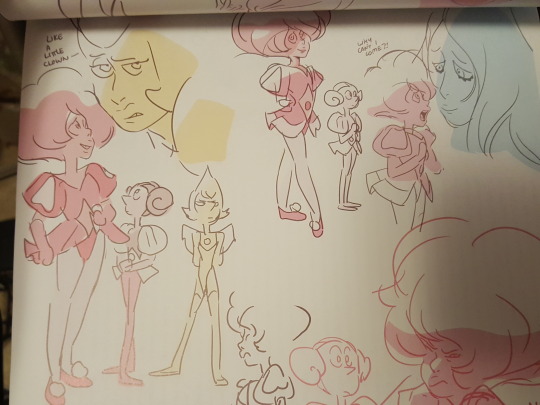
When it comes to visual cues, Rebecca also talks about intentional designs to create a feeling of unity between concepts, like the flower shapes on Pink Diamond's palanquin lining up with the poofs of Steven's hair and the star imagery of the series. Steven Sugar and Mary Nash discuss how the Human Zoo incorporated this imagery, trying to look like Homeworld with a Pink Diamond touch.
Steven Sugar, as a game nerd, liked to throw in video game references from old and modern stuff to feel like he's inserting what he's enjoying and who he is from moment to moment, while Mary Nash, who related to Sadie as a basement-dwelling young person with cult interests, liked to include stuff from MST3K and cult movies. Pearl's hand gestures get a spotlight too--her reflex to cover her mouth when Pink Diamond was being discussed was analyzed here.
A "Top Secret Visual Timeline" from 2016 is included which tells us some Diamond history. It has an earlier version of Pink Pearl's fate and does not include Spinel since the movie hadn't been greenlit. The timeline includes the birth of the Diamonds, the emergence and major story beats for each major character, and some philosophy of the driving force behind each.
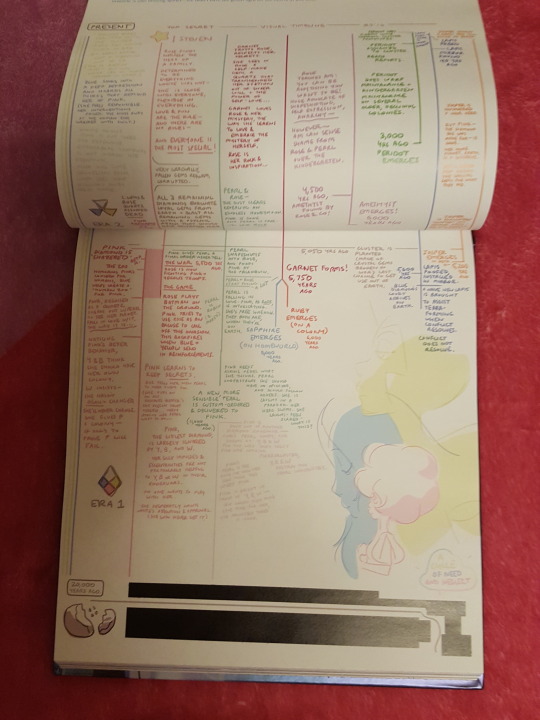
We're told that Pink Diamond straightened up, behavior-wise, after she lost her first Pearl, and that Yellow and Blue wanted to give her a planet but White only agreed to it to prove she would fail at managing a colony. Pearl, meanwhile, is so confused to have a Diamond who keeps asking her what she thinks when she doesn't believe she should have opinions.
And when Pink moonlighted as Rose to start conflict, she found herself leading an army to fight Pink's troops--then Yellow's, and eventually Blue's too. Lapis is said to be waiting for the conflict to end on Earth so she can terraform, but she gets trapped instead.
Pearl's love story with Rose is described as "an endless honeymoon" where she's free to love her, while Rose's is more like "I'm now the head of the family and I'm going to give everyone what they never had, so everyone is super special!"
Jasper is described as "adopted" into Yellow's army as the only successful Beta Quartz. And White Diamond knew that Pink Diamond was not dead--she thought she was just running away from home like a brat and would eventually be back.
3. THE HEART OF THE CRYSTAL GEMS
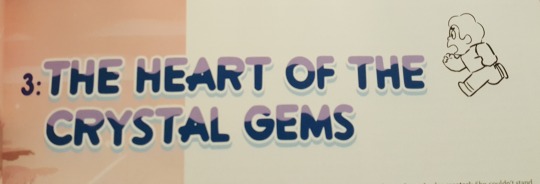
Now we discuss Rose Quartz--the original Pink Diamond. How she was selfish and selfless, never enough and always too much, and how Greg was her first partner who "challenged her" to be an equal. Rebecca describes Rose as being delighted by the idea that both she and Greg reinvented themselves, but when that leads her to want to share her past, Greg isn't interested--he only wants to know who she is now, and doesn't consider the old her to be her.
Rebecca likes Carl Jung's concept of "enantiodromia," which is the idea that extremes lead to their extreme opposite. This is demonstrated in all of the Diamonds. This narrative is interspersed with drawings of Greg and Rose being cute.
But another "heart" of the Crystal Gems is its relationships--particularly, Garnet, the fairy tale romance embodied. More psychological theories are discussed with regard to differentiation in a relationship making the relationship stronger, and how they made sure that happened for Garnet during the appropriate arc. Rebecca has struggled with the idea that she, like Ruby, went straight from a "family" group to a living-with-others situation and never lived by herself. But she also learned that you can in fact develop as a person in the context of a relationship--you don't have to be alone to do it. Ruby learned that too, and chose on her own terms to be with Sapphire.

The wedding made so much sense to Rebecca and the crew that they couldn't imagine a wholesome couple like Ruby and Sapphire not having a wedding episode. They wanted it for years: The wedding concepts always included the tuxedo for Sapphire and the wedding dress for Ruby.
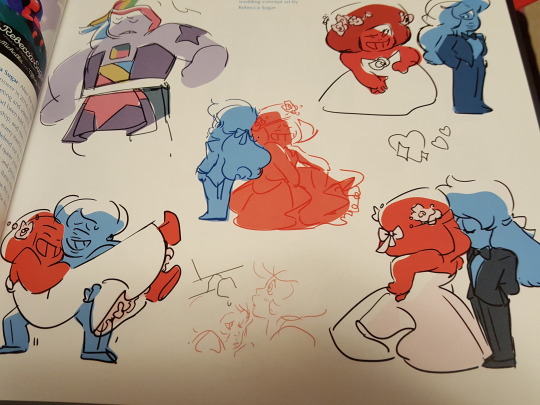
But pushback (often blamed on the conservative standards of the international market) led to negotiations trying to keep Ruby and Sapphire's relationship from being explicit. Rebecca and the Crew were very tired of this double standard, and they were especially irritated by attempts to claim a wedding wouldn't be well received by a core demographic or wouldn't make sense for Steven's character. But other shows had done weddings and Steven had been established to love weddings already.
Rebecca kept adding more elements to the wedding episode to answer all the concerns, but she didn't want to back down from explicit marriage between these characters. They deserved it. And the audience deserved to see this as wholesome, like any other cartoon wedding. Eventually they got their way and were allowed to have the wedding. But the ordered episodes were also coming to a close without promise of more, so Rebecca had to request more episodes to be able to wrap up the storyline!
And of course, there is Steven, the true heart of the team. A very interesting aside discusses Garnet's leadership and how the network pushed the Crewniverse to acknowledge Steven as the leader. This was successfully resisted throughout as well--because Garnet is the leader (unless she's incapacitated, of course). It's fantastic that this concept was preserved because too often a young male chosen one is elevated above people with more experience and knowledge because of that chosen one tradition, so it's really nice to have a show acknowledge that team leadership is more appropriate for an adult.
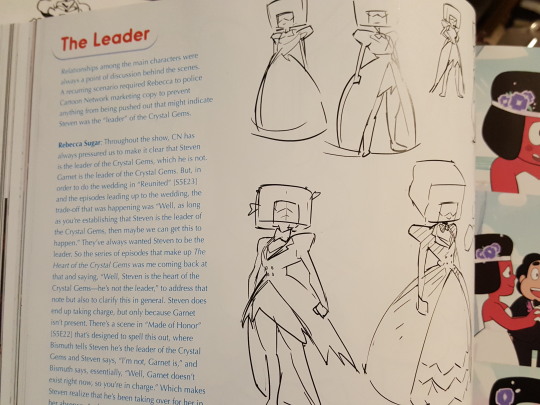
4. ERA 3
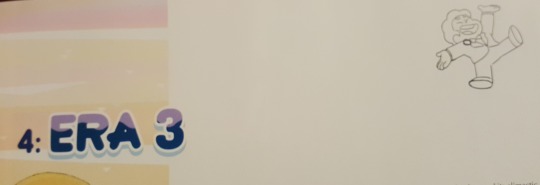
Beginning with a discussion of the Diamonds, this chapter deconstructs the dysfunctional "family" of the Diamonds (who are said to be based on tropes about evil stepmothers and stepsisters), with the thread of dysfunction originating with White Diamond.
Yellow is physical, Blue is emotional, White is judgmental, and Pink is impulsive. Some philosophy on why Pink is naturally manipulative and why she clashes so much with White is offered.
White believes her identity is to be imposed on all because she is the pinnacle of what should be--and therefore, she has the right to make decisions and statements about and on behalf of everyone. But her secret is that she can't do what the others do--act or feel or want. In trying to be everyone, she is no one.
And this becomes very important when she confronts Steven about his identity and turns out to be wrong. The triumph of Steven being totally, fully himself is a beautiful, simple revelation that's described as far more satisfying than the theories about Pink living inside him or Rose returning from his Gem.
Also discussed is Gem architecture. A lot went into this idea, and Steven Sugar weighs in to say he had to think of what it would mean for a world to have buildings but serve no human needs. That's why it's mostly focused on transport and storage. Even the broken planet is meant to indicate a place stripped for its resources, and everything serves a function that is meant to avoid looking like the human equivalents.
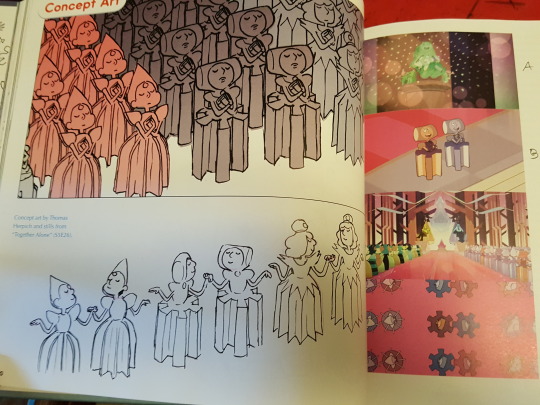
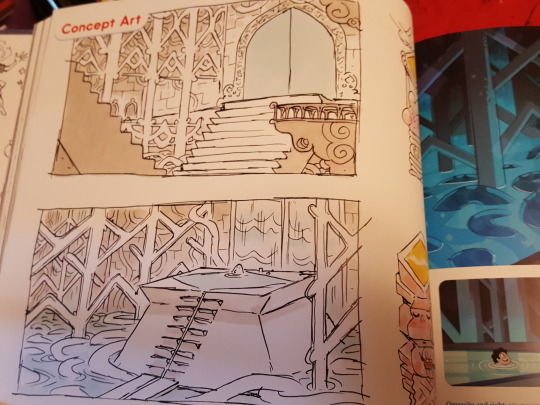
And there's another layer, too: a difference between Era 1 and Era 2. Era 2 became more functional to hide Era 1's broken bits, and older Homeworld buildings still have some "ornate and ancient" feel to them. And the fact that props, tools, and even walls and doors could be living was taken from a concept Rebecca thought was horrible from old Busby Berkeley movies, where people were inanimate objects and it was portrayed as lovely. Tom Herpich helped conceptualize these living objects.
Steven dealing with "princess tropes" is discussed here too. The Pebbles (worked on with Pendleton Ward) were sort of his Cinderella's mice, and all the locked-in-a-tower, having supportive tiny friends help you, getting princess clothes made, attending a ball, having to mind your manners stuff was intentionally related to fairy tales.
The point of doing that (besides fun) was to easily invoke the feeling that Steven was being made to be someone he's not, and that he was being treated like THIS is who he really is when it isn't. White Diamond as the "evil stepmother" is discussed with regard to her detailed features and massive scale. They generally didn't put fingernails and eyelashes on characters (especially not to indicate that they were women or girls!), but they decided White would get all of these feminine markers for tradition's sake.
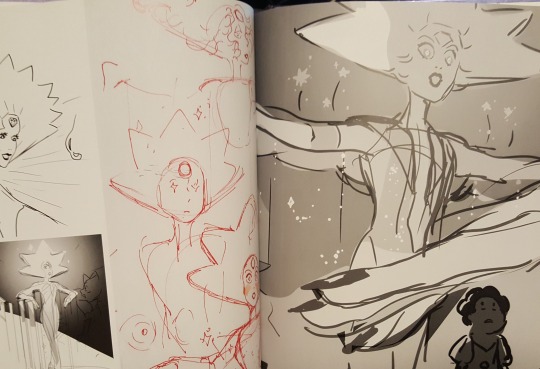
Rebecca also invokes several other references that were included and describes the princess tropes as "chipping away at his integrity" setting him up for the final challenge with White.
There is again tons of concept art: Homeworld architecture, Pebbles, Diamond diagrams, background Jades and Lemon Jade Fusion, Comby, Diamond extraction chambers, and White Diamond.
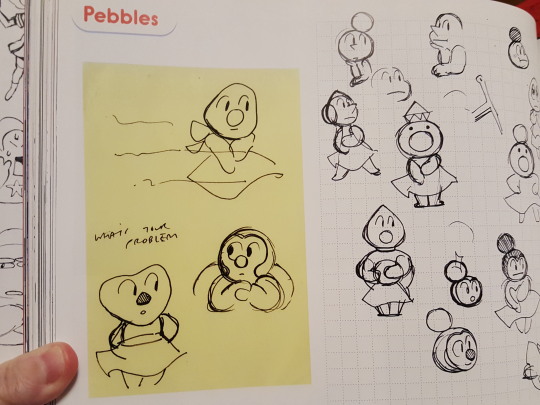
5. CHANGE YOUR MIND

Now we finally begin to discuss Steven's identity. The "Perfect Steven," discussed in several interviews before this book's release, was an idea back in 2013; the "ultimate Steven," beefed up and shonen-looking, was far from perfect because OUR Steven is perfect, while this alpha hero Steven idea (used in Steven Universe Future) didn't belong being idolized in such a show.
They thought about having Steven fall apart into organic half and Gem half early in the show (during "Giant Woman" after a successful fusion and unfusion, even!), but they didn't try the concept until the last episode. They didn't want the "Pink" Steven to be portrayed as "better" even though he would be more powerful, so they decided he isn't whole without his organic self and he's just as much of a shell as the organic half. They absolutely did not want any ending that required Rose to be inside him or waiting to come back. But the debates were fierce--what DOES it mean to have Rose's Gem?
Ian Jones-Quartey brings in an anecdote about his own family to emphasize some of the immigrant themes that inspired aspects of the show. He had a brother who reinvented himself elsewhere away from family without resolving issues, and all the ramifications of that were explored in the show through Rose Quartz. (He is careful to say he doesn't think his immigrant experience is like being from another planet!) But he did say you can hurt your old family even if they were toxic or didn't know the real you, and you can hurt your new family by hiding your past. The Pizza family of course was also a more direct reference to Ian's Ghanaian family.
In talking about the new Fusions from this episode, Sunstone is largely described by Miki, who also got to board the Sunstone section. Sunstone was described as a cool 1990s character and the evolution just continued into making them a fourth-wall-breaking PSA dispenser. Obsidian is also discussed, with their sword being an early concept. Steven Sugar said they totally knew it would be forged in action. Obsidian being similar to the Temple design is of course another very early detail.
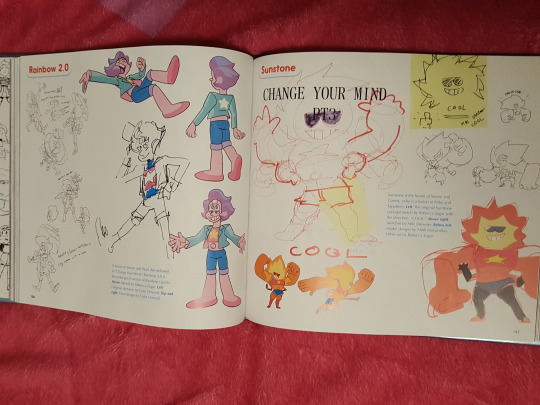
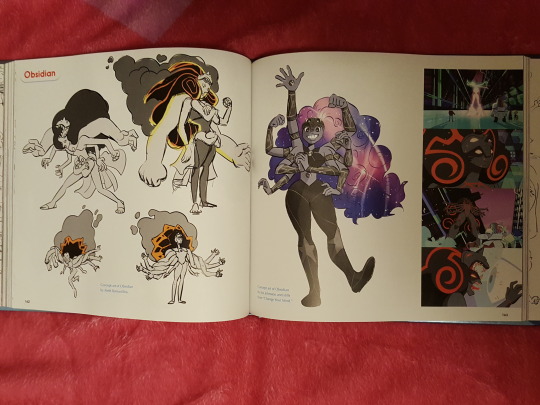
The story of how James Baxter got involved with one of the final scenes (Organic Steven and Pink Steven fusing in front of White Diamond) was shared. His family was fans of the show and Rebecca Sugar took the time to drive to a birthday party for his daughter and give her a drawing. He then owed her a favor, and this was it.
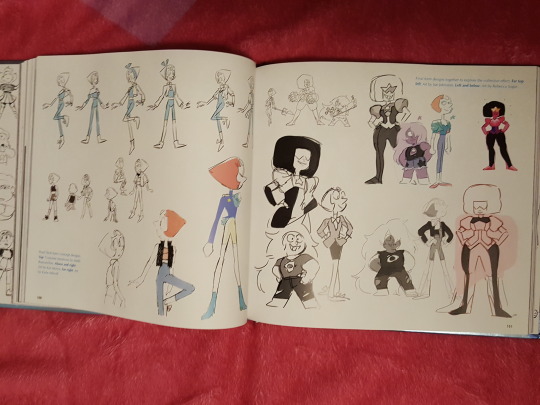
Concept art is again included, this time with sample boards, promo images, a Diamond fight concept, costume design changes for the Gems, new Fusions, the so-called "Mega Diamond" ship conglomerate, some scenes from the White Diamond confrontation, Pink Steven, multiple pages of James Baxter animation, corrupted Gems and their healed selves, and photos from the "Change Your Mind" premiere and some awards. The show has won one design-related Emmy, a Peabody Award, and a GLAAD award.
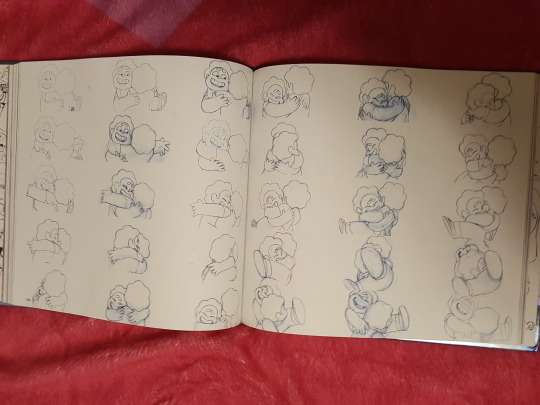
6. STEVEN UNIVERSE FUTURE
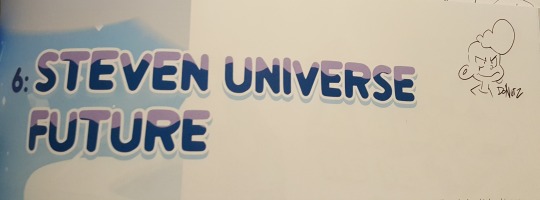
The book doesn't cover the movie because it got its own book, but dives right into Future. Ian Jones-Quartey emphasizes that the movie and Future are separate and different from the original show, which ENDED. After all, after that, Steven has a neck!
Some new names are invoked now: new writers Kate Tsang, Jack Pendarvis, and Taneka Stotts. They were excited to have Steven make HIS OWN mistakes instead of trying to clean up someone else's! Now, instead of doing the usual shonen anime thing and having the final battle be a big physical rumble, Steven has to make peace with himself and take an active role in coping with what all the fighting has done to him and what effect it's had on who he is (and who he wants to be). There is no sudden "I love myself!" answer, either. It's always a process.
Drew Green and Maya Petersen, who came on board as storyboarders officially in Future, also weighed in on writing for a "mature" show, how to deal with Steven being a "moral compass" while being sort of unreliable, and what they learned as Crew that they didn't know as fans. Drew didn't know Garnet never asks questions. Jack didn't realize the show never deviated from Steven's point of view. Taneka was nervous but excited to collaborate. Kate was worried about how established the show was and what to do as a new writer to contribute appropriately.
Maya was on the old Crew but not as a storyboarder, so felt like some of the "old" ideas ended up not being appropriate for the "new" Future in an embarrassing way--and dreaded the idea of dealing with Steven's emotional problems when they were similar to stuff she'd been through. She also was personally behind the idea of Steven wanting to dump his problems by becoming Stevonnie, and got to work with Etienne Guignard on inventing the Pearl creation backstory with Volleyball.
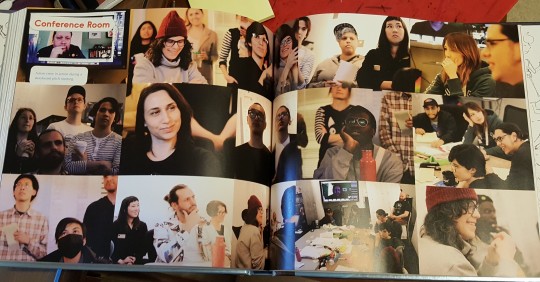
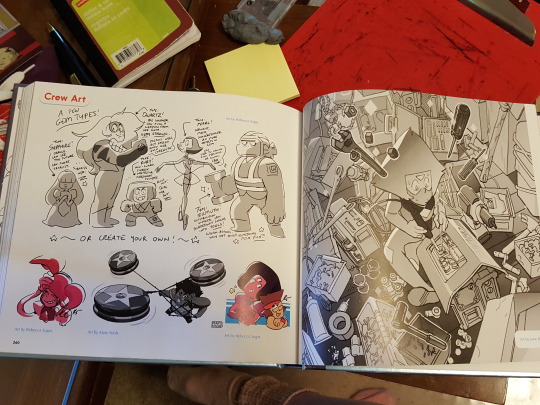
There's some discussion of "depression hobbies," stress, and the show's pacing. And they say Etienne was entertaining at pitches. There's even some discussion of how Greg is taken off a bit of a pedestal because his terrible restrictive life in the suburbs sounded wholesome to Steven and Greg presented it negatively.
And then there is some information about how the Crew felt behind the scenes due to fan reactions and negative press. Ian discusses feeling offended when the Black characters are described as bad examples, as if their cartoonized but realistic-in-context features are automatically caricatures.
Rebecca Sugar felt beaten down by some of these narratives and began to access mental health services, inspiring some of the content of "Mindful Education." A long reflection from Rebecca discusses people's infighting about her show and what she had a responsibility to show or not show in the story. She learned a lot about bullying from Cartoon Network's anti-bullying program and learned that bullies thrive on whatever attention you give them--unless it is made clear to them by a peer group that no one is impressed by their cruel actions. Also, not all negative feedback is bullying. Constructive criticism is different. Self-awareness can help you avoid internalizing what bullies might do or say to you.
Segueing from the discussion of how people are affected by and connect with the show, we then discuss how they chose as a team what should be covered as the show came to a close. They didn't have time to do quite a few stories they wanted time for, like a Rhodonite story, a Lars side story, and Diamond "prehistory" and religion; all of it was put aside for the main arc with Steven.
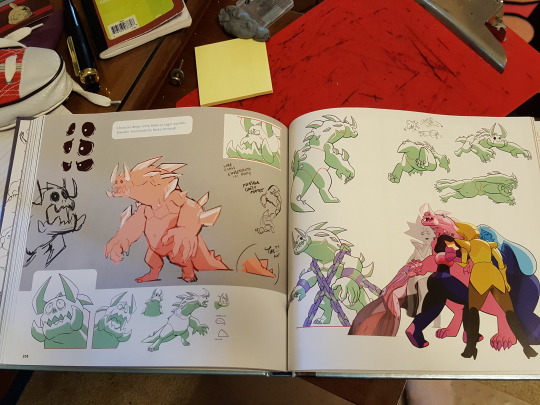
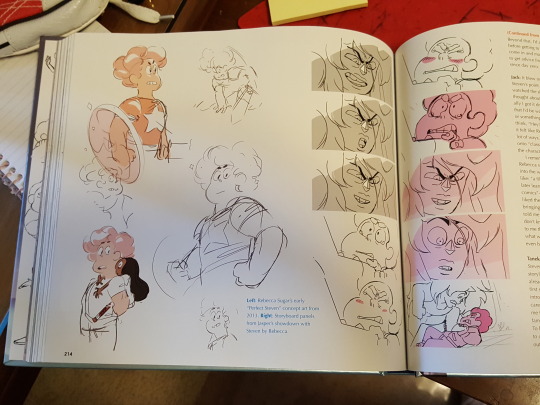
They thought people would find those stories about Homeworld and Off Color history very interesting, but so much of the show had been about Steven's Gem adventures, so keeping him mostly on Earth seemed appropriate. The acknowledgment of his battle damage, of his trauma, was necessary and real, and helpful in an important way to the core audience.
Oh, and there was some stuff about a cheeseburger tree. Don't ask.
In discussing the "reverse escapism" of the original show (Gem aliens are intrigued by everyday human culture, and realism is necessary), Rebecca says her views have changed on escapism and gets why some people want a soothing feel-better show. She acknowledged also that her own escapist dreams-come-true fulfilled in the show didn't feel like escapism because they were givens to the majority of mainstream culture, but were never guaranteed to marginalized people.
Rebecca ties in her several-times-told story about "Love Like You" and how the middle bit was when she didn't feel she was worth looking up to, and the realizations she had to tie the beginning to the end. Feeling like someone will like you less if they know you more is terrible. So sometimes a show like this can be helpful in telling people that they belong when their fantasies are things like "I want to be loved" and "I want to know I exist."
In Future, Steven has to connect to who he is and love that person--and understand that person enough to finally feel that even if he's not fixing their problems or saving their world right this second, Steven deserves his family's love and support, and they WANT to give it to him.
There's a huge amount of supplemental material in this section so there's no way I could name it all. The charts for Future's timeline are pretty straightforward, though a few episodes like "A Very Special Episode," "Why So Blue," "In Dreams," and "Bismuth Casual" aren't specifically represented and a couple are in a different order ("Prickly Pair" was conceived as happening after "Fragments" and "Homeworld Bound").
Steven feeling like a monster, having intrusive thoughts, having not forgiven the Diamonds, and getting help/moving on--it's all there.

We have keys, color scripts, and boards for the new opening and some various backgrounds and storyboard art from episodes. Model sheets for Shep, Nice Lapis and Mean Lapis, Jasper, Steven Tag Gems, Pink Steven Powers, Monster Steven. New house concepts, Era 3 Homeworld concept art for the Diamond environments, and background art for the Reef.
New Connie and Greg designs. Concepts for Mega Pearl, the Rose Quartzes, Bluebird, and Morganite (who didn't get used). And there are some photos from recording and the conference room. There are even some extras from "Crossover Nexus," the crossover with OK K.O.!--including an unused cut scene that included Ruby and Sapphire fighting. The rest of the book is a bunch of adorable Crewniverse art--extras, blog drawings, promos, and gifts to each other.
NOTABLE
1.
The first timeline chart in the book features a cool sketch of the original Off Colors, which at the time this planning document was drafted included unused Off Colors Flint and Chert.
We knew of their existence already because of an episode of the podcast, but these two unexpectedly appeared as incidental characters in the Steven Universe Future episode "Homeworld Bound," identified only in the credits. Sad to think that instead of banding with the Off Colors, these two were probably shattered for their crime (being Quartzes who don't want to fight) and that's why we see them being repaired in this episode. Later, there's some brainstorming for types of Off Colors and "a Ruby that wants to wear limb enhancers" is mentioned as well.
2.
It looks like there was also originally more juice to the story of tracking down the events of the war culminating in Pink Diamond's assassination.
One of the timelines talks about Steven thinking it makes sense that Pearl can't talk about her involvement because she might have been a double agent, explaining why Rose Quartz always knew what Pink Diamond was doing. It seems like that bit was supposed to be included in Garnet's version of the story she believed in "Your Mother and Mine." Seems like they originally conceived Garnet's story to inspire the Off Colors to become pirates and freedom fighters, though in the show's canon this storytelling happened after Lars had already reinvented himself the way he did.
Sadie was also supposed to be sending letters to Lars via Steven, which is funny since the "Letters to Lars" episode is just a montage Steven letter. And of course it's specified that Steven was supposed to get Pink Diamond flashbacks by going to the Palace on Homeworld.
3.
The second chart in the book makes references to Sadie's reinvention of herself as a parallel to Lars, Greg, and Pink Diamond all doing the same thing, and how positive it is to embrace such a thing--a version of yourself that YOU create.
I love that Yellow Diamond's arm ship arm-wrestling the Cluster was always part of the plan.
There's some more explicit direction to have Connie help Steven understand the Diamonds as "strict parents," and a lot more emphasis on everyone realizing Rose had been inspired by THEM rather than them all following her.
White Diamond is presented here as if she thinks of Pink Diamond as a "daughter" (whom she now understands she has "lost"). There are notes on how the Diamonds have a responsibility to their children and should attend to it before just continuing to make more.
4.
One of the concept art images for the Off Colors features Rhodonite crouching by Padparadscha saying "Don't worry, I won't let them hurt you." It's very interesting because she DOES seem to protect Padparadscha in the show, but doesn't seem confident about it in her final version, even though it does seem like she'd be "programmed" to guard aristocratic Gems because of her Ruby and Pearl makeup. Cool.
5.
A "Crew Cameos" spread was included, which is of great interest to some of us who loved seeing the Crew insert themselves into the show. Not every SU Crew person who's been represented in a crowd was there, but this crowd included Amish Kumar, Kat Morris, Amanda Winterstein, Angie Wang, Lamar Abrams, Emily Walus, Mary Nash, Joe Johnston, Christy Cohen, Danny Cragg, Hilary Florido, Danny Hynes, Matt Burnett, Ben Levin, Elle Michalka.

6.
The official national flower of South Korea, Hibiscus syriacus, is the name of Pink Diamond's flower.
7.
One of Steven Sugar's comments about the silhouette difference between humans and Gems points out that humans have ears. This seems to be pretty good confirmation that they are not supposed to have ears, despite that sometimes we'll see ears drawn on them in some frames.
8.
Rose Quartz/Pink Diamond is characterized in this book as "self-hating" in a really interesting way, saying that because she believed she was not capable of compassion, she practically worshiped those who demonstrated that ability and thought they were so much better than her--which is described as "intoxicating" and resulted in others being drawn to her. How interesting is that!
9.
Timelines reveal that early plans for Pink Diamond's first Pearl originally had her getting destroyed by Pink during a game, and then her destruction was rewritten as a punishment from the Diamonds after Pink Pearl defended Pink Diamond to the other Diamonds. They went back to the idea of her getting hurt by Pink for the final version, though the cracked face and control by White Diamond was not on the agenda until they started writing "Change Your Mind."
10.
The approximate ages of the major characters, based on emergence, are revealed on these timelines. It begins with a cracked-planet-looking graphic depicting four tiny Diamonds emerging at 20,000 years ago. Some suspicious "blacked out" redacting surrounds a long timeline tail that goes back before that, which may mean there are secrets they still don't want to reveal. But the dates go like this:
20,000 years ago: The Diamonds emerge.
11,000 years ago: Pearl is custom-made for Pink Diamond.
8,000 years ago: Sapphire emerges (on Homeworld).
6,000 years ago: Ruby emerges (on a colony).
5,750 years ago: Garnet is formed.
5,600 years ago: Lapis is poofed and put in the mirror.
5,200 years ago: Jasper emerges (on Earth).
5,050 years ago: The Cluster is planted.
5,000 years ago: Amethyst emerges (on Earth).
4,500 years ago: The Crystal Gems found Amethyst.
3,000 years ago: Peridot emerges (on Homeworld).
40 years ago: Pearl found Lapis's mirror at the Galaxy Warp.
And of course we know 14 years ago Steven is born!
11.
Originally the Diamonds were based on a quartet of themes: Love, Fear, Pride, and Sorrow. It got too complicated to keep and it was abandoned, with Pink's identification of "love" being described as "particularly outdated."
12.
Notes on a sketch say that Pearl was inspired to become bold and unashamed because Pink's questions drove her to have opinions, and it's said that Rose "fell in love" with her boldness.
13.
Rebecca tells the story of driving off a ridge and getting stuck in the desert, comparing this to Ruby's tumble during her Wild West adventure and using it as inspiration. She's told this story before but here it is in print. She also included the story about using the flowers from a friend's wedding to put in Ruby's hair.
14.
Rebecca describes having to "fight" notes she was given when it had to do with Ruby and Sapphire's relationship. One she describes as NOT fighting was for a signing card depicting Ruby and Sapphire dancing. It was called "too romantic" and she decided not to worry about it since it wasn't the actual show content.
She was also scolded over her book The Answer because the powers that be expected her to downplay that relationship. She always argued that queer youth deserved these things.

15.
Tom Herpich describes being inspired to name Blue Diamond's comb "Comby" because he was watching the news about Comey getting fired from the FBI. It's also a mineral-related term and I always assumed that reference was intentional, but maybe it's not and this is the only intended significance to Comby's name?
16.
Rainbow Quartz 2.0's design is not discussed, though the other two new Fusions from "Change Your Mind" (Sunstone and Obsidian) were. RQ2 has some sketches included, but no accompanying narrative in the text.
17.
A sheet of corrupted Gems and their healed selves is offered, though it doesn't appear to be final. The obelisk in "Serious Steven" is labeled Albite. The unnamed Worm Monster, Desert Glass, and Watermelon Tourmaline are included. An unnamed birdlike Gem represents the Big Bird monster from "Giant Woman." The crab monster from "Arcade Mania" is labeled Blue Chalcedony. The Tongue Monster is drawn uncorrupted but not named. The Flower Monster from "Back to the Kindergarten" is labeled Grossular Diopside or Titanite. The invisible monster from "Island Adventure" is labeled Moonstone. The Lighthouse Gem is labeled White Topaz. A form for Larimar that was used in "Change Your Mind" but changed in Future is there. The Slinker is listed as Chrysocolla. And the Crab Monster is listed as Aventurine.
On the next page, this is changed to Bixbite (as it was in Steven Universe Future), and we then also have Lace Amethyst, Blue Lace Agate, Crazy Lace Agate (Fusion), Ocean Jasper, the Mother Centipeetle Nephrite (Facet 413 Cabochon 12) and three other Nephrites, Angel Aura Quartz, a hooded Jasper, Zebra Jasper, Biggs Jasper, Watermelon Tourmaline (labeled as Fusion of Gem * Onion--huh?), Snowflake Obsidian, "Little" Larimar, and Orange Spodumene (who was the Worm).

18.
The Rhodonite side story would have been about the love story of a Ruby and a Pearl working for Morganite. Images of Morganite and her servants, unfused, are in the book. We do not get this additional information, but Rebecca said in a panel shortly before the book's release that Rhodonite's story would have been about finding out that she had been Rejuvenated 17 times because her components kept falling in love and needing to be reset.

19.
Referring to the Diamonds on one of the charts, Steven's perspective is "I can't believe I helped these" and then there's a censor bar. Welp.
20.
Some included art by Hilary Florido features Kevin with a souped-up Koala Princess car and another where Kevin is staring at himself in the mirror in front of an altar to himself.
21.
Rebecca's sweater collection is included in the Crew art.
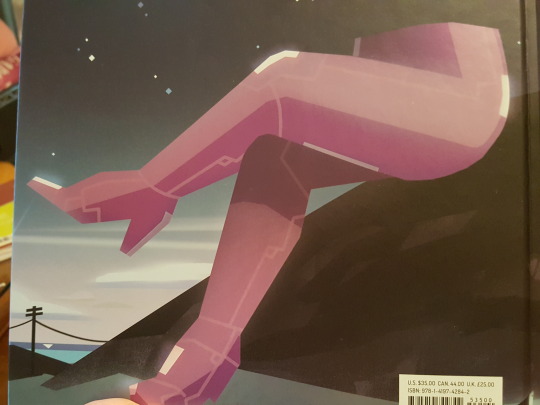
[SU Book and Comic Reviews]
142 notes
·
View notes
Text
Treat Your S(h)elf: Tribe: On Homecoming and Belonging by Sebastian Junger (2016)
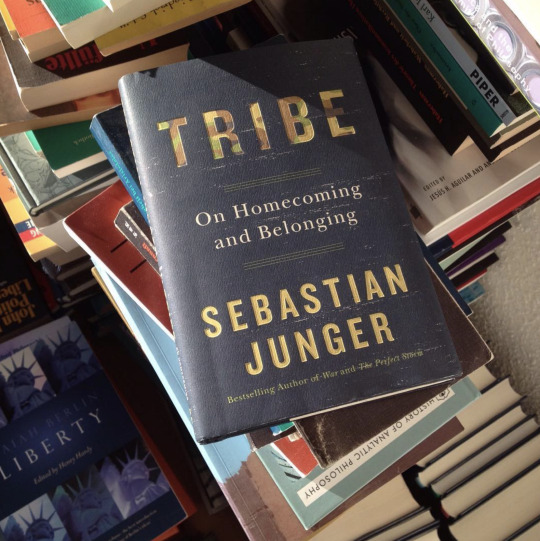
“Humans don’t mind hardship, in fact they thrive on it; what they mind is not feeling necessary. Modern society has perfected the art of making people not feel necessary. It's time for that to end.”
- Sebastian Junger, Tribe: On Homecoming and Belonging
The phenomenon of tribal solidarity is the subject of Sebastian Junger’s enthralling book, Tribe: On Homecoming and Belonging. Junger offers a rich but unevenly researched patchwork of history, psychology, and anthropology to explore the deep appeal of the tribal culture throughout history. The result is less of a tour de force book that I would have expected from the likes of Sebastian Junger than an interesting and thought provoking read. Certainly it should be read by anyone interested in the human condition.
As a British ex-military veteran and a fan of Junger’s other books I naturally found it fascinating.The memory of my most recent tour in Afghanistan was still raw upon my return to Britain. Although the book really focuses on returning American army servicemen and their integration back into the American ‘tribe’ there were several themes that I and many others who had seen war could readily identify with.

“Tribe” is not a typical Junger book. He doesn’t tell one knockout story, as he did in the “The Perfect Storm,” which made him rich and famous, or as he did in “War,” which — along with his documentaries “Restrepo” and “Korengal” — established him as one of the world’s most mesmerising chroniclers of the Afghanistan war. Rather, he gives us an extended-play version of an article he wrote for for Vanity Fair — one that’s part ethnography, part history, part social science primer, part cri de coeur. Junger previously served as a war correspondent for Vanity Fair, embedding for long stretches at remote American outposts in Afghanistan’s frightful Korengal valley. This experience may help explain his interest in the intimate bonds that define tribal societies as well as the despair that can come from being wrenched out of a situation that makes those bonds necessary.
Junger’s premise is simple: Modern civilisation may be awesome, giving us unimaginable autonomy and material bounty. But it has also deprived us of the psychologically invaluable sense of community and interdependence that we hominids enjoyed for millions of years. It is only during moments of great adversity that we come together and enjoy that kind of fellowship — which may explain why, paradoxically, we thrive during those moments. (In the six months after Sept. 11, Junger writes, the murder rate in New York dropped by 40 percent, and the suicide rate by 20 percent.)
“I do miss something from the war,” Bosnian journalist Nidzara Ahmetasevic tells Sebastian Junger halfway through the book. Ahmetasevic is talking about the wartime closeness she shared with friends in a basement bomb shelter in besieged Sarajevo. “The love that we shared was enormous,” Ahmetasevic says. “I missed being close to people, I missed being loved in that way.”
The sentiment lies at the heart of Tribe, a book offering a surprising thesis about the ways humans have traded communal belonging for excessive safety.
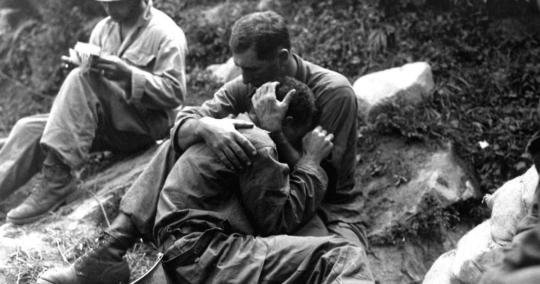
Junger gets a considerable amount done in a quick 133 pages: Tribe posits a reason why white settlers found life among Native American tribes appealing, theorises about false PTSD claims among returned U.S. veterans, and conveys the author’s equality-minded view of how heroic behaviour varies between genders — all in addition to remarks on hitchhiking, attachment parenting, Junger’s dad’s opinion of military service, and more. It’s an awful lot of ground to cover in such a short book, and it’s inevitable that Tribe would either feel inchoate and sketched or else aggravatingly dense. Because Junger is an adventurous storyteller (rather than, say, an academic theoretician), he opts for the former.
It’s not necessarily a good thing. The book’s lightness makes it accessible, an easy entry point to weighty subject matter. But its concision can make Tribe feel breezy even as it discusses life and death — if not sometimes confusing.
As a former anthropology major, Mr. Junger takes a special interest in tribal life. He notes that a striking number of American colonists ran off to join Native American societies, but the reverse was almost never true. He describes the structure and values of hunter-gatherer groups, including the ones that lasted well into the 20th century, like the !Kung in the Kalahari.
Unfortunately, these parts of the book are also the dullest and most problematic. There’s a numbingly familiar quality to much of the social science research he cites. It is not exactly news that nations with large income disparities are less happy than those without them, or that group cooperation increases levels of oxytocin, the bonding hormone. He notes, for example, that American mothers in the 1970s had a level of skin-to-skin contact with their babies that traditional societies would consider criminally low. Fair enough. I wonder, though, if he realises that in saying this he’s crashing open the gate for every helicopter parenting (or attachment-parenting) demagogue out there? And that parents who actually have to go to work for a living - and therefore can’t have their babies pinned to their chests all day long for three years straight - will read these words and start rolling the eyes back in disbelief.

Though Junger cautions against romanticising tribal cultures, he sometimes does exactly that, and in ways that can be annoying. Tribe aptly opens with Benjamin Franklin’s observation, decades before the American Revolution, that more than a few English settlers were “escaping into the woods” to join Indian society. Franklin noticed that emigration seemed to go from the civilised to the tribal, but rarely the other way around. White captives of the American Indians, for instance, often did not wish to be repatriated to colonial society. At this distance, it is simply astonishing that so many frontiersmen would have cast off the relative comforts of civilisation in favour an “empire wilderness” rife with Stone Age tribes that, as Junger notes, “had barely changed in 15,000 years.”
The small but significant flow of white men — they were mostly men — into the tree-line sat uncomfortably with those who stayed behind. Without indulging the modern temptation to romanticise what was a blood-soaked way of life, Junger hazards an explanation for the appeal of tribal culture. Western society was a diverse and dynamic but deeply alienating place. (Plus ça change…) This stood in stark contrast to native life, which was essentially classless and egalitarian. The “intensely communal nature of an Indian tribe” provided a high degree of autonomy — as long as it didn’t threaten the defence of the tribe, which was punishable by death — as well as a sense of belonging. Tribe is then essentially a critique of modern civilisation, beginning with Junger’s observation of the inexorable appeal of Native American way of life to early settlers (“The intensely communal nature of an Indian tribe held an appeal that the material benefits of Western civilisation couldn’t necessary compete with”).
“The question for Western society isn’t so much why tribal life might be so appealing - it seems obvious on the face of it - but why Western society is so unappealing.” Junger is making a provocative point, but he is no provocateur. He swiftly justifies this jarring idea:
On a material level it is clearly more comfortable and protected from the hardships of the natural world. But as societies become more affluent they tend to require more, rather than less, time and commitment by the individual, and it’s possible that many people feel that affluence and safety simply aren’t a good trade for freedom.

All of these points have been covered in other, heavier books. Jared Diamond’s The World Until Yesterday examines traditional tribal lifestyles’ usefulness in the present day. The entanglement of war with human closeness and purpose is the focus of Chris Hedges’s War Is a Force That Gives Us Meaning. (Both Hedges and Junger include the same anecdote, in fact, about a teenage couple in besieged Sarajevo, that dies, sniper-shot, on the banks of the Miljacka River.) Junger also briefly mentions the work of seminal disaster researcher Charles Fritz, noting that Fritz could find almost no examples of mass panic during large-scale disasters. This plays into his overarching point that difficult experiences can be unifying rather than shattering. The exact same studies by Fritz and fellow researchers — and that exact same, crucial point — are detailed in Rebecca Solnit’s brilliant A Paradise Built in Hell.
Junger uses these insights towards another point. “Because modern society has almost completely eliminated trauma and violence from everyday life, anyone who does suffer these things is deemed to be extraordinarily unfortunate,” he writes. “This gives people access to sympathy and resources but also creates an identity of victimhood that can delay recovery.” This is an important observation. It, too, resonates quite closely with previous work - in this case Harvard psychiatrist Judith Lewis Herman’s seminal book Trauma and Recovery, which remarks that “to hold traumatic reality in consciousness requires a social context that affirms and protects the victim and that joins victim and witness in a common alliance.”
At best what Junger tries to achieve, then, is to assemble parts of all those books into one slim volume. So much the better for the busy reader. Unfortunately, Junger’s quick look at violence, trauma, and modern anomie also omits important information from other books, and as a result ends up on shaky ground, failing to consider counterpoints or bring its own arguments to a close.

Junger in the second half of the book proceeds through an examination of how disastrous or violent circumstances can create similar human closeness, and includes a discussion of how our society’s distancing itself from such harsh conditions has inadvertently sharpened those events’ capacity to traumatise the people who endure them.
War is hell, so this scourge of loneliness may seem the inevitable price for those who fight in them. The second half of Tribe insists that this impression is gravely mistaken. “Studies from around the world show that recovery from war is heavily influenced by the society one belongs to,” Junger observes. Iroquois warriors, for instance, did not have to contend with much alienation because the line between warfare and normal Indian society was vanishingly thin. This is not to deny that the Iroquois were traumatised by combat, but it was generally acute PTSD, limited in duration and distress. Their trauma was ameliorated by the fact that the trauma was shared by the entire tribe.
War, then, for all of its brutality and ugliness, satisfies some of our deepest evolutionary yearnings for connectedness. Platoons are like tribes. They give soldiers a chance to demonstrate their valour and loyalty, to work cooperatively, to show utter selflessness.
Is it any wonder that so many of them say they miss the action when they come home?

Part of the takeaway from this book is that regarding military service as a source of permanent psychiatric disability is incorrect for most (American) soldiers. Junger includes a lengthy discussion of how the U.S. Veterans Administration mishandles former soldiers’ mental health issues, and how America’s cultural misunderstanding of war plays into that deleterious milieu. The information isn’t wrong per se, but what it has to do with the rest of the romanticising of foregone tribal way of life, etc., or why that necessitates anything more than the 2015 Vanity Fair article from which the book sprung is never quite made clear. Worse, Junger says that the low rate of combat engagement among U.S. soldiers means their diagnoses of post-traumatic stress disorder often aren’t real - but he fails to consider that some soldiers develop PTSD from military sexual trauma, or from other adverse experiences outside of combat or before their enlistment.
Worse, he seems to misunderstand the diagnosis entirely. Here, as in the Vanity Fair article, Junger describes his own bout with what he calls “classic short-term PTSD,” departing from this insight to further dissect trauma and the ways modern society misunderstands it. The problem is, there really is no such thing as “short-term PTSD.” It sounds like what Junger had was post-traumatic stress, a weeks - or months - long psychological adaptation to adverse events (in his case, exposure to war) that typically resolves on its own.

Although psychological care can sometimes be relevant, most mental health professionals don’t regard this as an illness. (Tellingly, Junger’s approach to his diagnosis involved little more than an acquaintance’s ad hoc comment at “a family picnic.”) Post-traumatic stress disorder is only diagnosable after three to six months, does not often go away on its own, and can endure for a lifetime if untreated. The implication that Junger’s case is typical PTSD is misleading - and to some extent, calls his conclusions into question.
The problems in his argument go even deeper. “In Bosnia — as it is now — we don’t trust each other anymore; we became really bad people,” Ahmetasevic tells Junger. “We didn’t learn the lesson of the war, which is how important it is to share everything you have with human beings close to you.” Junger’s thesis is that other cultures (the “Stone-Age tribes” white settlers once joined) did learn that lesson. But he assumes that violence is innate to humans and necessary for human closeness, never parsing evidence that it is not. And he doesn’t examine what this Bosnian journalist means by “really bad,” and how becoming so after the war might have arisen directly from the painful, long-lasting effects of the severe trauma Junger doesn’t quite seem to believe in.
If there is any doubt on this point, consider the alarming rates of PTSD among our warrior class, and the desire among many of them to return to war — a subject on which Junger has been at the leading edge of the public discussion. When combat vets return home, the alienation and aimlessness of modern society aggravates their psychological traumas and prompts them to yearn for the brotherhood of combat. It’s not for nothing that a recent book on post-traumatic stress is entitled The Evil Hours.

Many soldiers actually miss war. “Adversity,” he writes, “often leads people to depend more on one another, and that closeness can produce a kind of nostalgia for the hard times.” Soldiers go from a close-knit group in which everyone has a purpose to a society in highly individualised lifestyles are “deeply brutalising to the human spirit.” Soldiers who come home to situations in which there is no social support from family and community are more likely to suffer PTSD than others.
Thanking veterans for their service aggravates the problem, in Junger’s opinion. “If anything, these token acts only deepen the chasm between the military and the civilian population by highlighting the fact that some people serve their country but the vast majority don’t.” Tickets to games and other such perquisites can incentivise veterans to see themselves as victims, making their reintegration into society much more difficult.
What they really need is the one thing that will make them feel like valuable members of society: jobs. In their tribe-like military units, they each had a specific function without which the group could not perform. The worst thing that can happen to them when they return is to feel useless, marginalised. The suicide rate in America mirrors the unemployment rate, Junger points out. The best protection against devastating depression is meaningful work.
“Ex-combatants shouldn’t be seen - or be encouraged to see themselves - as victims,” writes Junger. Lifelong disability payments for PTSD, which is treatable and usually not chronic, actually debilitate veterans, Junger claims. In war, the passivity of victimhood can be deadly, he explains. Turning veterans into victims when they return is not only confusing but also destructive because it erases their sense of self. Instead of sympathy, “veterans need to feel that they’re just as necessary and productive back in society as they were on the battlefield.”
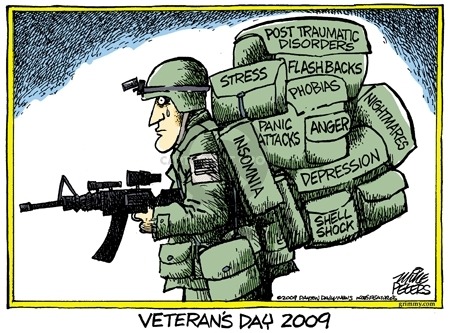
Of course much of this book is really around the American experience of war and the experiences of American veterans returning home. So some points don’t quite stick with either British or European experiences. For example neither British or other European societies thank veterans for their service as a matter of course. Of course there are special days to commemorate major war events and even an armed forces day but on a general day to day basis one doesn’t go up to a military person to thank them for their service probably because British and European servicemen and their service don’t enjoy a privileged standing. Respected and admired yes, but not deified. How British and other European countries take care of their returning veterans is hard to detail as the experience varies in terms of disability allowances and other measures. Certainly a misunderstanding of mental trauma or PTSD of returning veterans has led sometimes to a criminal mismanaging of taking care of those most affected. Again, it varies from country to country.
Contemporary America is a considerably less consolidated society than it used to be. Cultural diffusion and economic stratification have increased the isolation felt by those who have borne the heat and burden of battle. I won’t a forget photograph shown to me by an older brother who had served with distinction in Iraq. He made a few American friends from the US soldiers serving there alongside and one day he was shown something that captured the dark humour and cynicism of war. The photo captured a graffito scribbled on a wall in Ramadi, Iraq, that read: “America is not at war. The Marine Corps is at war. America is at the mall.”
Multiple studies demonstrate that “a person’s chance of getting chronic PTSD is in great part a function of their experiences before going to war.” The relationship between combat and trauma seems to be a murky one. For instance, “combat veterans are, statistically, no more likely to kill themselves than veterans who were never under fire.” Junger says that even a significant number of Peace Corps volunteers report suffering severe depression after their return home, especially if their host country was in a state of emergency when they did. In Junger’s telling, particular burdens endured by socially disadvantaged Americans - from a poor educational background to chaotic broken family life - can make a candidate especially susceptible to PTSD. Indeed, these risk factors “are nearly as predictive of PTSD as the severity of the trauma itself.”

The decline of social order and solidarity has contributed to a loss of what researchers call “social resilience.” This has simultaneously supplied more potential candidates for PTSD and impaired society’s ability to help them recover. The United States must place a premium on boosting its levels of social resilience. Americans should no longer be content to simply thank veterans for their service; sporting events are not places of healing. Nor should they seek to outsource the responsibility to the federal government. The solution lies closer to home, in the mediating institutions of civil society — from families to churches to community and professional associations. I think this echoes the views of quite a few veterans in my experience with them.
More sensitively and perhaps controversially, ex-combatants shouldn’t be regarded, or encouraged to regard themselves, as victims. This I also agree with. America is still a tremendously affluent country, Junger writes, that can afford to perpetually care for a victim class of veterans dependent on government largesse, “but the vets can’t.” They have generally performed exemplary service for which they should be honoured, and they must know that their service is not over.
Next, Junger says, veterans (like most social animals) depend upon a sense of purpose that begins with a job and a position in society. Here the “hire vets” initiatives and retraining programs are necessary but insufficient. The traditional means of securing social resilience has been egalitarian social provision. Individualist America may blanch at that notion, but it should at least act to build a more open economy and inclusive culture where individuals can reliably advance by merit and develop social capital.

Not being an American I don’t wish to speak out of turn but as a veteran and especially in speaking with other British and foreign veterans I think Junger is on the right path. Victimhood and a lack of purpose are the unseen enemy that the returning veteran will continue to fight when he or she comes home.
To all this I would also that - arguably perhaps in America especially - a revival of national cohesion is needed if - as a nation that pays lip service to honour the sacrifices of its servicemen - it is to arrest the full savagery of battlefield trauma. This will require what Edmund Burke called “a revolution in sentiments, manners and moral opinions.”
One clue about how to achieve this can be found in the early pages of Tribe, when Junger tells an affecting anecdote about his father. Not long after the end of the Vietnam War, the author had received a Selective Service registration form in the mail, in case the United States government ever needed to conscript him into the military. When he announced that, if drafted, he would refuse to serve on political grounds, his father’s reaction caught him off guard. Although sternly opposed to the war in Indo-China, Junger’s father insisted that American soldiers had “saved the world” from fascism during World War II and many never came home. Junger writes;
“‘You don’t owe your country nothing,’ I remember him telling me. ‘You owe it something, and depending on what happens, you might owe it your life.’” This did not oblige anyone to enlist in an unjust war - “in his opinion, protesting an immoral war was just as honorable and necessary as fighting a moral one” - but it did mean that the country had just claims on its citizens, and refusing to sign a registration form constituted a dereliction of duty.

Year after year, Americans hear arguments for taking the stink out of their sulphurous political rhetoric. It would be better for congressional productivity. It would be better for our international dignity. It would be better for their national literacy, their local advocacy, their general civility and the future etiquette of their children. But the one argument I had not heard, until reading Junger’s book is that they should clean up their act for the sake of their returning troops.
Junger never makes this point explicitly. What he writes, simply, is this: After months of combat, during which “soldiers all but ignore differences of race, religion and politics within their platoon,” they return to the United States to find “a society that is basically at war with itself. People speak with incredible contempt about - depending on their views - the rich, the poor, the educated, the foreign-born, the president or the entire U.S. government.” Soldiers go from a world in which they’re united, interconnected and indispensable to one in which they’re isolated, without purpose, and bombarded with images of politicians and civilians screaming at one another on TV and cable.
It’s a formula for deep despair. “Today’s veterans often come home to find that, although they’re willing to die for their country,” he writes, “they’re not sure how to live for it.”
With that, Mr. Junger has raised one of the most provocative ideas for bitterly divided Americans to grapple with without mentioning a single political candidate, or even a president, by name.
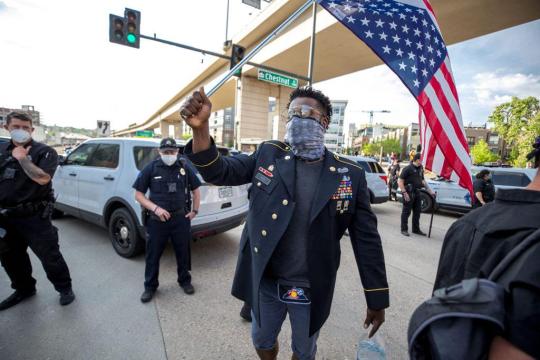
In this age of social and economic fragmentation, many of America’s disadvantaged fellow citizens have begun to chafe against an elite class - left and right - that often behaves as if it were exempted from the national compact. Junger only hints at the necessary leap beyond a social-psychological view to a political-economic analysis. He writes, "As great a sacrifice as soldiers make, American workers arguably make a greater one…. [w]orking in industries that have a mortality rate equivalent to most units in the US military." He suggests, "It may be worth considering whether middle-class American life - for all its material good fortune - has lost some essential sense of unity that might otherwise discourage alienated men from turning apocalyptically violent."
Nobody then should be surprised if the ranks of disaffected citizens – not least those who have borne arms in our name and in their defence - ultimately decide that the sensibility of the tribe is superior to their own.

As a proud Brit who is guilty at times of poking fun at America but borne out of sincere fondness and respect for America I do sincerely hope during these turbulent times that they are capable of coming together and recognising their tribal identity is to be Americans first and other labels (liberal or conservative or red state or blue state) whilst not inconsequential are not important enough to undermine the primary American tribal identity. They did it so marvellously after 9/11, but that feeling as we all know soon dissipated. It can’t afford to be a house divided from within when there are predatory wolves pawing at the door (I’m looking at you Russia and China). Junger correctly writes America is a strong nation, “The only one who can destroy us, is, well, us…..which means that the ultimate terrorist strategy would be to just leave us alone.”

Tribe is an important, thought-provoking book that encourages Americans to see its veterans and American society in a fresh light. Policymakers of all political stripes would do well to consider Junger’s arguments, for as long as they fail to fully integrate returning soldiers, everyone will continue to pay a high toll for their incredible service and sacrifice.
Junger’s “Tribe” even if it was written in 2016, remains relevant and serves as an important wake-up call. Let’s hope we all don’t sleep through the alarm. But this too brief and too scattershot book with an important message won’t get us all the way there. There is an old South African Zulu proverb, ‘If you want to go fast, go on your own. If you want to go further, go together’. It’s up to all of us.
#treat your s(h)elf#book review#books#reading#sebastian junger#junger#tribe#war#battle#america#army#society#culture#anthropology#native indian#iroquoi#veterans#PTSD#integration#civilisation#state
196 notes
·
View notes
Text
Fashion Analysis: Nancy’s Purple work dress and Others Part 2
We’re back! We examine how Nancy’s dress stands as a beacon of great (admittedly mostly white) feminist hope, Karen Wheeler passes the torch in a consciousness-raising session, and we explore how purple has been used in other period pieces.

Nancy has been no stranger to purple before, wearing it as a symbol of her passion, youthful innocence, and heightened emotion. She wore it in the library when she thought she saw Barb (despite the knowledge that her best friend died) and she wore it the day that Steve invited her for a get-together at his mansion (with a pool!) and it’s something that she promptly changes out of before getting in the deep v-necked, chevron striped sweater to look a little more sexier.
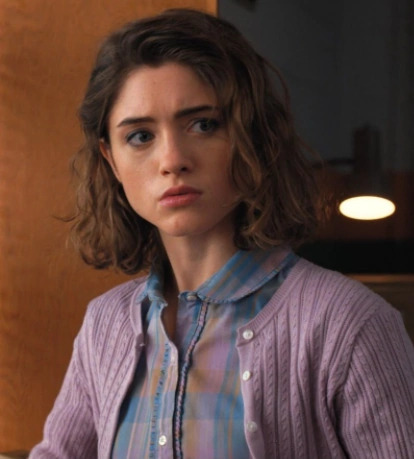
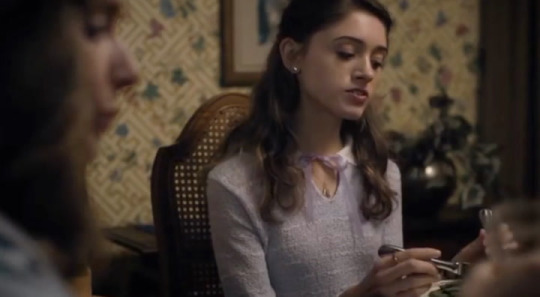
Now the purple is no longer pastel, it’s a saturated lilac that is updated for the times and reflects how she is no longer the naive girl in a ballet slipper necklace. After she talks about her struggles in a misogynistic office with her mother, her mother begins to open up, in colors that look subdued but symbolic (except for the makeup).

First check the colors: lavender tones and yellow. Purple on her eyelids. Put a pin those colors (I want to note that a bold red lip remains timeless) and that necklace. We are going to explore the mystique of Karen Wheeler: Model 1980s Housewife and peel some layers with the help of some other ladies in period pieces and her exposition.
We learn that it was likely Karen Wheeler had her own dreams aside from the conventional and traditional life she leads as a bored housewife (who got close to adultery) until casual misogyny led her to abandon those dreams presumably because she “wasn’t smart enough” or “good enough” and stopped trying. Some other ladies (also with incredible hair) would relate outside of the series.

A savvy bombshell who had to negotiate sexism to get what she wanted, until she left men behind for now.

A young woman in her own bold shadow giving the news to her (unappreciative) boss that she is leaving for better things.
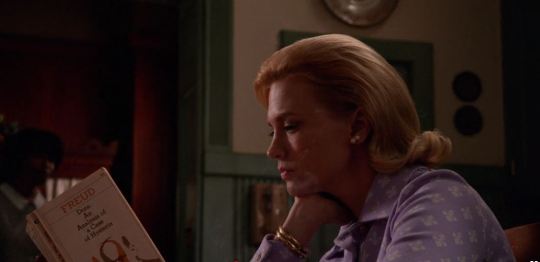
A conventional wife and mother who always relied on her own beauty to get the attention and praise she needed and made the radical choice to go back for a Master’s degree.

A disappointed young girl in sensible (and feminine) cardigan and button up shirt listens to whatever a male relative is trying to tell her.
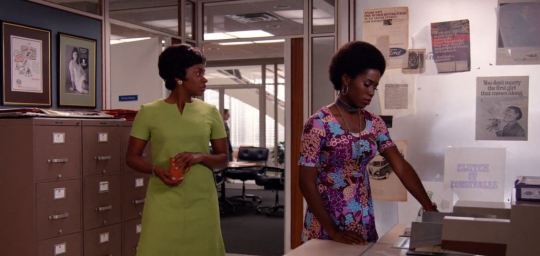
Two secretaries are reminded vividly of how disposable they are in a white male patriarchy but cannot confront the men themselves.

A sheltered proud homemaker questions her life choices as she is surrounded by women who insist on making bolder moves for their lives and change society for all women. She also finds she is very naive to how life works.
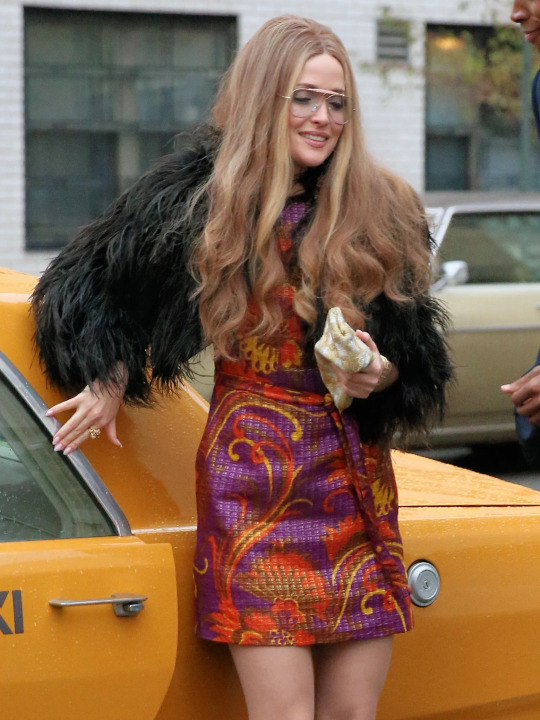
A woman who is renowned for her beauty and glamour fights to be recognized for her skills and intellect, tries to bring different people together, and is willing to confront authority figures on their wrongdoing. She also questions why a woman can’t be considered both beautiful and intelligent.
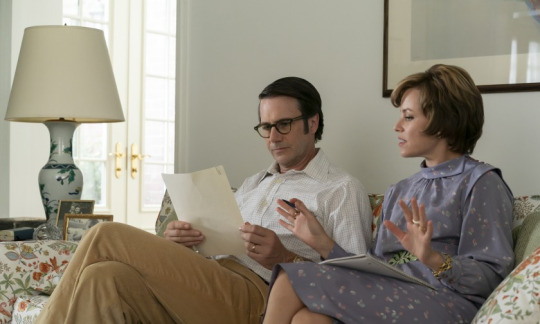
A hardworking wife and mother tries to use her influence to improve the status of women and manages to fight anti-feminists while enjoying tea time with her daughters and their friends. She is also challenged with expectations for how wives were “supposed” to behave.
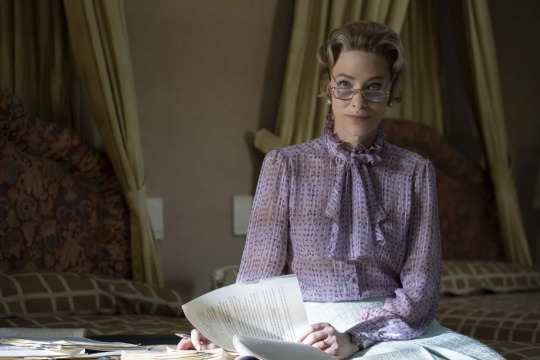
A woman, with a impenetrable veneer of perfection, attempts to negotiate her way to patriarchy by exploiting the image of traditional feminine perfection and keeping women's’ status, well, static. She loses out when she sees that no matter how many bodies she shoves under the bus, the men above her do not appreciate her efforts on their behalf.
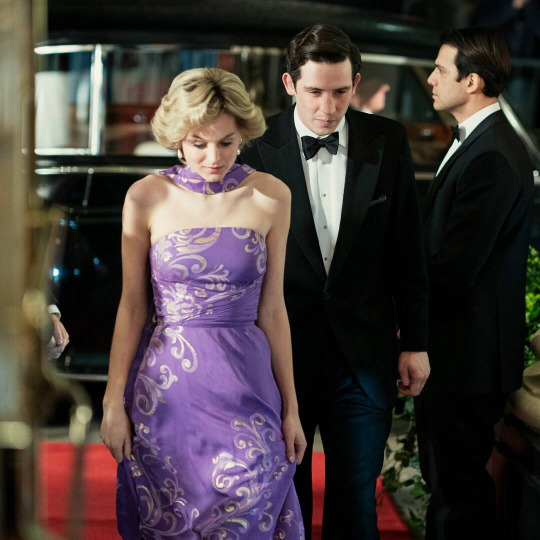
A young and beautiful princess grapples with issues of being a trophy wife, mother, her own roving eye after a marriage to a much older (and unappreciative) patriarchy, and her yearning to be her own person.
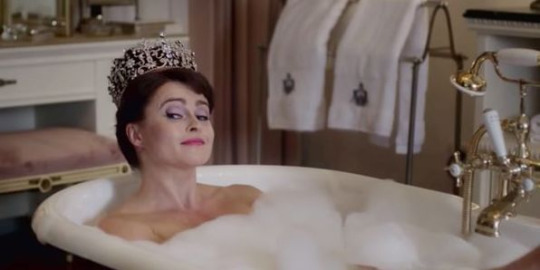
A princess goes bold with her makeup, hair, and clothes to gain the attention she has been socialized to expecting. Trying to be a bombshell and “with it” while dealing with a crumbling marriage, feeling overshadowed by others, and no positive outlet for her intelligence.

A vivacious and stylish housewife grappling with the painful realities that men can be fickle and that gender roles don’t offer women any outlet for their ambitions or a safety net for when things get really bad, she learns she will have to make bold choices to better her circumstances.
All these women, like Karen, have made choices to survive the patriarchy and live life on their own terms. Some succumbing to the patriarchy, others revolting against it, and one who would betray others to win her seat in the boardroom. Many of these women are/were noted for their beauty only to find that other people (men) didn’t expect them to be insightful or smart; some of these women were wives and mothers who loved those roles but chafed at the idea that they’d give up their autonomy and individuality to be excellent at those jobs; a few came into motherhood and marriage rather young, before getting to experiment and mature their way through girl’s trips, work, and messy experiences. And many of them chose a different path for themselves aside from being a domestic and maternal figure, probably swearing off it for their own reasons. That was (and still the reality) of many women in Karen’s generation especially. Those were the options open to her and she chose the option that seemed to reap the most benefits.
Now about Karen’s sartorial choices? First the necklace.

As noted in Seventeen magazine, many fans on the internet noticed the shape her necklace took, looking similar to a vaginal opening with the pearl as a clitoris. Given how heavy the male gaze was in the 1980s, this was a impressive expression of female sexuality. Given the look and symbolism (given added weight from the feminist pep talk she gives Nancy), it’s quite impressive for the conventional PTA mom whose front lawn held a Reagan/Bush ‘84 sign (just look up their policies on reproductive health and sex education, I recommend Gloria Feldt’s The War on Choice: The Right-wing Attack on Women's Rights and how to Fight Back). Then we go from Second Wave Feminism of the prior decade all the way back to First Wave Feminism’s use of White, Purple, and Yellow.

White dresses stood out against men in their dark suits and were cheaper to maintain (laundry practices at the time caused colors to run) and reflect how white mainstream figures of the movement really were, after all Nancy and Karen are upper-middle class, white, cishet, conventionally attractive preppy suburbanites in Indiana and their experiences wouldn’t 100% match those of transgender women, working-class women (Joyce), women in abusive households (Max), traumatized women (El), women of color (Erica), larger or “outlier” attractive (Barb), or lesbians (Robin).
Gold/Yellow stood for “Hope”, Purple for “Loyalty”, and White for “purity” (given that name “Karen” means “Purity” from Nordic origins, it’s pitch perfect).
Hope and Loyalty embody the Party of Stranger Things, as to why Purity isn’t mentioned here, we will go in the 3rd part (all the racial implications can be looked up) and see the group get intersectional.
#Stranger Things#The Crown#The Marvelous Mrs Maisel#Mrs America#Mad Men#1980s Fashion#costume analysis#period costumes#fashion analysis#feminism#Nancy Wheeler#Karen Wheeler#Purple#Intersectional Feminism#Alice Macray#Joan Holloway#Peggy Olson#Dawn Chambers#Shirley Mad Men#Betty Draper#Sally Draper
28 notes
·
View notes
Text
Chaos Rising Review (Spoilers under the cut)
Non-spoiler review:
Star Wars: Thrawn Ascendancy (Book I: Chaos Rising) is a fascinating new book by Timothy Zahn that takes us on a journey between the “present” and flashbacks, looking at Thrawn’s early days starting with the Academy. It’s an examination of how these experiences slowly serve to build him up as the character we have come to know in the newer “Imperial Trilogy”, as seen in Thrawn 2017, Thrawn: Alliances, and Thrawn: Treason.
“The peace of the Ascendancy, a beacon of calm and stability, is shattered after a daring attack on the Chiss capital that leaves no trace of the enemy. Baffled, the Ascendancy dispatches one of its brightest young military officers to root out the unseen assailants. A recruit born of no title, but adopted into the powerful family of the Mitth and given the name Thrawn.
With the might of the Expansionary Fleet at his back, and the aid of his comrade Admiral Ar'alani, answers begin to fall into place. But as Thrawn's first command probes deeper into the vast stretch of space his people call the Chaos, he realizes that the mission he has been given is not what it seems. And the threat to the Ascendancy is only just beginning.”
For me, this book has become a personal favorite on par with Thrawn (2017), and it does so by bringing an amazing cast of characters to life in the galaxy far, far away. Learning about them and how they interact with Thrawn and each other is the book’s greatest strength.
The way the Chiss culture is explored here feels fresh and gives the Ascendancy a life of its own. There is a tug of war going on between the military and the civilian side of their society, something I was looking for beyond the conflict of the Empire and the Rebels/Republic. This also means the Ascendancy has a “complicated” relationship with Thrawn that adds to what we already know is his weakness… politics.
For newcomers, this is a great starting point. You’ll get to the core of who Thrawn is and why he behaves the way he does during the “Imperial Trilogy”. There’s still a very marked difference between this Thrawn and the Rebels version, which makes me appreciate the books even more. You’ll root for these characters and wish things turn out well for them because we know that getting swept up in Thrawn’s plans can be a very dangerous proposition.
Thrawn’s genius still shines through during the battles and while we know he survives these encounters, there are consequences and repercussions for each of his victories and for the people around him. In any case, while you can obviously expect math and physics to play a big part during the battles, this might be the story with the most HEART of all the Thrawn books. There are moments of joy, sadness, fear, confusion, and a fair amount of HOPE, things we don’t always get from a Thrawn-centric story. It affected me deeply and I read it again as soon as I finished. Hopefully, you’ll feel the same way.
I'm so grateful to Zahn for writing this story and I can’t wait to see where it goes in books two and three. I highly recommend this book!
9/10
SPOILER REVIEW:
From the very beginning, I was swept up in the emotions of the story, something I was not expecting. The memories of young Thrawn getting thrown into the politics of the Mitth and the struggles of being a Navigator from Thalias surprised me by how much my heart hurt for them. And yet, there’s always a hint of hope and that reminder that someone in the universe does care, bringing a smile to my face.
Seeing a socially awkward Thrawn fumble his way through, even with his fellow Chiss, and trying to find his place in the world is a real treat. As someone who constantly checks herself about not rambling on about my interests, because I fear I’ll upset people or they’ll think I’m weird, it made me really identify with this younger version.
For the characters, the one I loved maybe the most was Che'ri, the nine year old navigator assigned to the Springhawk, providing us the point of view of a sky-walker. It can be difficult to read sometimes, how these children are experiencing their situation and the people around them in a very distinct way. I really felt her anxiety, her loneliness, her fear, and her hope. Zahn did a wonderful job with her and those with “Third Sight” Force abilities.
And speaking of Che’ri, we learn that she was the pilot who was with Thrawn during his adventure with Anakin Skywalker in Alliances! Experiencing that first encounter with the future Darth Vader, from Thrawn's and Che'ri's POV, was perfect and very sweet. I’m so glad that we get confirmation that Thrawn is actually very understanding and patient when it comes to kids. Indeed, he looks for ways to encourage them, to become the best version of themselves, as he’s helping anyone willing to learn.
The other equally important character is former sky-walker and Che’ri’s caregiver, Thalias. I have to admit, I was a bit skeptical of Thalias at first when she’s introduced to us as an adult. I loved her first encounter with Thrawn as a child inone of the “memories” chapters, but I worried for her grown-up version. I was starting to fear Zahn was setting her up just to be a romantic interest for Thrawn, and while it didn’t happen in this book, I still see the potential for that later on, especially when her goal becomes supporting Thrawn. And while it was a rocky start for me, I did come to like and appreciate her, giving us perhaps the most “humane” face of the Chiss so far. She became a favorite for me.
There was a bit about gender roles being a little too on the nose for me. It wasn't so much that it detracted from the story, but it was noticeable enough to make me raise an eyebrow once or twice. In any case, it was amazing to see how Thrawn is surrounded by capable women. The Empire Trilogy was a bit lacking with this, only having a few important females actually engaged with the main plot (Pryce, Faro, etc), but Chaos Rising was seriously an improvement.
And for people waiting for Thrass or Formbi, we don't exactly get to see them. There's one single mention confirming Thrass died but no other comment about him being Thrawn's brother or what transpired in the Vagaari incident. Instead, Thrawn mentions he believes he had a navigator older sister when he was very young and she was taken away. My mind was blown. No name was given, but I'm sure she will come up in some of the next books.
There is a callback to Outbound Flight, specifically Thrass and Thrawn’s iconic exchange about his wish to help people outside the Ascendancy. This time, Ar’alani is the one explaining they can’t do that, but she promises to support him if he gets high enough as an Aristrocra to change their policies from the inside. I think in general this sets an amazing precedent. You know me. I can't help but think about how this could influence future stories with Ezra and Thrawn. To see Thrawn's accomplishments and need to help others, even if he's forbidden to do so as well as how he risked his career again and again, going out of his way to stop these attacks, made me hopeful. I feel it resonates with what Ezra went through and reinforces in me the idea that the middle way he's looking for is them working together.
Going back to the book, while I felt the main villain (Yiv, the Merciful) was quite scary... there was something missing to make him truly memorable to me. I still can't place my finger on it. I'll need to read the book again to make a better judgement about him. In this case, I was not reading the book because Yiv felt compelling, but more about how Thrawn and company were reacting to him. And speaking of villains, the book ends with the reveal of a new enemy... but just like with Yiv, I felt disconnected from him. We only got a few lines from that one, so I can't tell for sure what to expect from him, but it seems like another guy in a long list of warlords that Thrawn will defeat. Which makes me wonder if we will get any female rivals in the following book.
In general, I loved the book. I loved the characters. I loved their struggles and how they get to solve these problems. Thrawn always has a card up his sleeve, but there will surely be repercussions for what he did at the end. We know not everyone is happy with him… but I can’t wait to find out what else he will do. In a way, this book would work as a stand-alone story if it wasn’t for that reveal at the end, so I believe anyone could grab it and have a great time.
#chaos rising#thrawn ascendancy#star wars#thrawn#review#spoilers#spoiler#chaos rising spoiler#thrawn ascendancy spoiler
40 notes
·
View notes
Photo

Our monthly book for our family’s Anti-Racism Book Club, Sister Outsider is a collection of essays by foundational Feminism theorist and activist poet Audre Lorde. It was interesting and illuminating to appreciate, as I read, that these essays were penned and published between 1976 and 1983 because so many of the concepts Lorde explores are central to how race, gender, and sexuality are discussed, in academia and in activism, today. Most notably, in my mind, are her descriptions of intersectionality and how intersectionality operates in each life, shaping our perspectives and experiences. Lorde doesn’t use the term “intersectionality,” but this is what she so profoundly describes, as she advocates for unity through diversity (and not “in spite of” or “by erasing” differences). She offers an incredible message of hope. The task she sets to all of us is not an easy one, but it’s a powerful one and one she deeply believes in: through seeing each other more fully, through understanding the intersections of someone else’s complex identity and where that identity does or does not overlap with our own, we can find shared humanity and shared conviction to fight for change.
Audre Lorde is Black, female, lesbian, and the mother of two children. Her perspective and experiences are shaped by these different aspects of her identity, and she explains how each part of her multi-faceted identity has placed her outside of society’s “norms” in a variety of contexts. Even within sub-communities, she has found herself on the outside because of one of her identities. She describes how, when hoping to attend a Feminism conference for queer women, she wasn’t sure how to attend and care for her teenage son, as no boys over age 10 were allowed at the conference. Lorde’s identities do not have a “hierarchy of othering” nor are they separable from each other. Through these essays, she shows how these identities are linked, yet one may be more central to certain experiences than others. She identifies with women across the Feminist movement, yet her Blackness is often misunderstood or blatantly judged by white women. She identifies with Black men struggling against racism, and speaks about Malcolm X and Martin Luther King Jr., but she’s repeatedly othered and traumatized by the violence against Black women perpetuated by Black men. She speaks out about the violence and hatred from Black people directed at other Black people and she does a lot to explain and examine “internalized racism” (another term that she describes without using this exact wording, and yet it’s a concept that’s important in race discussion today). I wondered whether Lorde is credited with developing these concepts, and how other thinkers built on her ideas, and where the specific terminology itself came from. I’ll do some more digging.
In our family discussion, my sister pointed out how much she liked the part in the Introduction—written by a white, Jewish, Lesbian mother—in which the author explained that Lorde’s explanation of and examination of her intersectional identity allowed the author to examine her own. Although these two women’s identifies are not the same, the act of intersectional thinking and awareness that Lorde demonstrates allowed the author of the Introduction to better think about these things in herself and to process how to discuss her complex identity with her son. I found this to be such a poignant point—that intersectionality can function as a tool. It doesn’t mean we need to identity with Lorde’s perspective in a specific sense (and the majority of readers will not be able to, having their own identities that are complex, but different than Lorde’s) but we can identify with her ways of thinking about identity. We can learn from her methodology and apply it to ourselves and to our interactions with others. There are a lot of aspects of our intersectional identities that we take for granted on a daily basis. These are the ones that align with the “norm,” the privileged identity in America, and therefore are those we are not forced by others to repeatedly be aware of…the world is designed to fit those aspects of identity. But that doesn’t mean we should not actively examine these aspects of identity as well, and I feel that intersectionality helps us do this, helps us “check our privilege” in these areas. If I read about the experiences of a Black, female lesbian, I gain new understanding of the things I take for granted in my whiteness and my heterosexuality. If I read something written by someone with a physical handicap, I gain new understanding of how I take my able-bodiedness for granted. This does not work only across one dimension, but across many dimensions simultaneously, as I feel affinity for Lorde in her femaleness, but also nuanced understanding of how her experience of being female has been fundamentally different than my own.
This book gave me confidence to speak up about race and identity, more so, I think, than any other we’ve read since June 2020. Because identity is so complex, I am going to make mistakes. I am going to be blatantly racist, sexist, homophobic, classist, and many more things, as these things are ingrained in all of us by society. I am going to be the most blind in the areas where I have experienced the most privilege. But each person’s identity is complex, and race conversations are not “us versus them”—it’s “me and you,” talking and processing, and trying to get to know our differences. Lorde has such a strong conviction in the process of unity, of coming through understanding of each other and each other’s diversity. And it’s clear that this is only achieved through closeness, through effort, through work and discussion (which is inherently painful because it works out the deep thorns of hatred). Lorde’s faith in this is so powerful and it uplifted me to try, with each person, to get closer to understanding their intersectional identities. I know that this is not a project that I can expect another person to enter into with me, and Lorde points to several times when she’s exhausted by this work, when she acknowledges how less emotionally-taxing certain conversations about race with white people would be if they were conducted by another white person.
I think that, on some deep level, I have always struggled with a fear of misspeaking about race. This is a funny fear to have because I have already misspoken about race. I have said things out of ignorance, out of racism, that have hurt others, probably more times than I know. I have had friends call me out. I have apologized. I have felt sad about the impact of my words. I have felt ashamed about my ignorance. Why would I still dread these experiences? I guess, because they are painful, and no one likes anything painful, but they are definitely less painful for me. So I try to overcome my fear of them. I think I am someone who craves the approval of others. I like to be liked, something cultivated from a very young age when I won the approval of teachers and of my parents by being a strong student. I didn’t really have the experience of disappointing someone (I probably should have, so I could have made tools earlier for dealing with it). Why do I want/need the approval of strangers? Why do I want to be liked? Why does this factor into a fear of judgment and of misspeaking? I think as I’ve grown up I’ve improved at taking criticism. I am good at taking criticism on things I produce: my writing, my school work, my work work. I am getting pretty good at taking personal criticism from loved ones—“you said x and that hurt my feelings”—I am good at admitting fault. I do not feel insecure about mistakes or failures. Yet, I’m somehow more afraid of hurting strangers, and the hurt that comes from speaking up and hurting others about race. My logical mind rejects this—“your hurt is microscopic and should not be the focus when you’ve hurt others”—but I also know I still feel this. I’m not doing a great job of talking myself out of it.
Audre Lorde, however, is. My favorite moment in this book is the following quote:
“If I speak to you in anger, at least I have spoken to you: I have not put a gun to your head and shot you down in the street…”
I felt this moment strike me deeply and shift something tectonic within me. I felt this change the way I thought about my fear. I felt the incredible power of someone telling me I’ve hurt them, of being willing and able to do that. Yes, I still would not want to hurt someone else because I would not want to hurt them. But I feel, in a new way, that I am not afraid of misspeaking on race because of the backlash on me. I need to try to not hurt others, but I will. And when I do, I will need to try harder. I will be grateful for words of anger because they are WORDS. Words are not something of which to be afraid; words are opportunities.
Another striking part of this book for me was the conversation between Adrienne Rich and Audre Lorde. I’m a big fan of Rich’s poetry and routinely taught “Diving Into the Wreck” to my students, as a way to talk about Feminism and identity. I really appreciated seeing these women converse, modeling, I felt, the approach to conversations around intersectionality that Lorde supports. These two women don’t hold back, and they don’t always agree. Yet, their friendship and trust deepens through their acts of disagreement and reckoning. The best part of this essay, for me, was when Lorde brings up how Rich asked her on the phone in a conversation around race to provide “documentation” of her perspective, as a way to help Rich “perceive what you perceive.” Lorde, however, takes this request as one coming from an academic/rationalist perspective, a perspective that has often been employed to discredit Lorde’s own, as a “questioning of her perceptions” (which, white men academics too often feel, are suspect when coming from a Black woman). Neither Rich nor Lorde backs off their approach—Rich tying this need for documentation to how seriously she takes the spaces between her and Lorde that she seeks to fill with information and understanding, and Lorde pointing out that documentation supports analysis and not perception, which is the way the world is directly received by her, a Black woman. I don’t think this conversation is colored by them being respectful of each other in their words and language, but by the honesty that is evidence of deep and true respect.
This book is bookended by two essays that take place aboard—the first in Russia and the last in Grenada. In both, Lorde has another identity that she comments on less explicitly, but that is nevertheless explored: that of the English-speaking American aboard. She’s supported by translators and guides throughout her academic trip to Russia, and she experiences Grenada in terms of the American Imperialist invasion that overwrote the narrative of the local people with whom she feels strong affinity through her mother. In Russia, Lorde compares and contrasts the systems she sees at play with American systems (the poor, horrified Russian man to whom she explains that Americans don’t have universal healthcare and if you can’t afford it, “sometimes you die”). Reading Lorde’s descriptions of her trips invoked in me a deep desire to travel, a pining for those experiences that I’ve tried to stamp down firmly in the past year, but travel has been such a significant part of my life over the past 5 years…it’s hard to silence my longing. (I cried yesterday morning about wanting to visit the remains of Troy where they’ve been unearthed in western Turkey near Canakkale…) I felt like these bookends helped me expand the principles of intersectionality beyond the American Black-white dynamic, although this is the hugest and most painful power dynamic impacting America today, to remember that these issues are universal. Lorde focuses more universally than some of the other authors we’ve read recently, focusing her commentary on all aspects of her identity, and not solely race. Struggles around race, gender, sexuality, nationality, and many other aspects of identity are occurring around the world, and it’s important to work to understand the intersectionality of others’ lives and experiences in a complex, nuanced way. By doing this, Lorde shows, we can direct our emotions and our efforts vertically, working to dismantle stratified systems of inequality, rather than battling over differences on a horizontal plane.
#sister outsider#audre lorde#important reading#talking about race#talking about sexuality#talking about gender#intersectionality#intersectional feminism#feminism#reading blog#fifth book of 2021
6 notes
·
View notes
Text
Love After the Fact Chapter 57: Wasting Time with a New Friend
Lotor makes some new friends. Together, they discover that word of Lance and Keith's union has reached video game developers in the worst, best way.
Featuring Leakira in the role of comic relief (Not to offend Leakira fans, this is meant to be a fun, happy place. I just thought it might be funny little detail) XD
First Previous Next
Lotor finds them sleeping in a hallway. A much-needed distraction.
More specifically, it’s an adolescent Olkari with orange feelers, dressed in green and white garb stained with red dust. They’re incredibly small, even for a smaller species. Pretty adorable, like a wolf cub.
So obviously he nudges them with his foot.
“Can I help you?” the kit growls, amber eyes glaring up at him.
“You’re sleeping in a hallway.”
“And? What’s your point?”
“... You know what? I’m not really sure.”
With a groan, the kit sits up, tugging on their feelers. “So what are you up to, Mr. Prince?”
“Oh not much. Wandering around, looking for trouble.” He’s actually looking for a distraction, but that’s almost the same thing as trouble.
“Trouble, huh?” The Olkari smirks. “I’m Pidge. Lance’s resident tech genius and vent crawler- I mean spy.”
“Ah-haha, I see. You’re one of his ‘associates’.” Lotor grins, helps Pidge to their feet.
“Yes. Working for Lance usually involves some level of trouble. What are the princes up to today, anyway?”
“Lance is with Allura. She’s having a hard morning. Keith is with Thace, our emergency medic and reproductive specialist.”
“Oh, really? Making sure his junk works?”
“That’s the idea. Why?”
“It’d be awesome to have some dirt on Keith. He’s just so perfect.” Pidge skips down the hallway, a curious prince following behind them. “The worst thing he’s done is drink a bit too much, find his happy place at a party, and get really snuggly with Lance.”
Following Pidge into what should have been an old, empty storeroom, Lotor’s eyes widen in surprise. The typically ignored room is set up with monitors and a work table covered with Balmeran crystals and a few other tools.
“Where did you get some of these tools?” he asks, eyeing a choice laser of Galra design.
“I crawled through the tunnels underneath the actual labs and stole them. I’m welcome in the labs, of course. I just don’t want to share my work with them. The field of science is rife with thieves.”
“You found the tunnels already?” Lotor stares. There are tunnels all under the mountain, his ancestors making the massive peak into an insect hive. There are escape tunnels and hidden caches and underground pools and even a forge made of volcanic glass that he discovered as a small boy.
He still likes to go down there on the rare occasion he can find the time. Someday, he’ll take his children down there, and tell them all about the stories carved into the ancient walls.
“Yep! Anyway, let’s see if I can hack into Thace’s equipment. And by that I mean give me like, thirty ticks because I can definitely do it.” While Pidge types away on their computer, Lotor sits himself on the floor, eyeing a faint square cut into the stone. Most people don’t notice, don’t know to look for the fine edges carved into the floor. “Ooh… Interesting.”
“What’s interesting?” Lotor asks. “Is Keith okay?”
“You really care for him, don’t you?” Amber eyes smile at him, intuitive.
“Of course I do! He’s my cousin! And my friend!” And he has more than his fair share of health problems. Lotor himself was not a healthy kit, so he understands the worries that his cousin might have.
“Aw-w. You’re just a big ol’ sweetheart, aren’t ya?” Pidge turns back to their computer. “What’s interesting is that Keith is… surprisingly healthy. His weight and body mass index are good… Thace is optimistic about a successful pregnancy.”
“Why is that interesting?” Lotor scratches his head, frowning a little.
“Because our boys requested contraceptives, probably due to health concerns.”
“Miscarriage risks are higher for him. That’s partially due to his sex, and partially due to his condition. Do you think they’ll use contraceptives?”
“Pfft. No. They’re young, they’re stupid, and they both want pups. I doubt Lance can keep it in his pants.”
“What about Keith?”
“He’s shy.” Pidge shrugs like that explains everything. It kind of does. Keith’s priorities are probably more of the cuddling variety than the ‘aggressive hugging’ variety. “Can I have some of your blood?”
“Hm? Uh… How much blood?”
“I dunno. A few vials? Maybe I’ll swab your cheek too? It might help with my experiments.”
“And what might those be?”
“I’m trying to invent Altean-friendly prosthetics. It’s not going well. Alteans are stupid inside and out.” Pidge gathers their tools to stick him, and Lotor stares. This tiny little Olkari is far more than they appear. “Who do you think will kill Lance for getting Keith pregnant? Krolia or Shiro?”
But they're young, still playful and carefree.
“Hm… My money’s on Krolia. Or the creepy friend.”
“Adam? Oh, he’s softer than he looks. More likely he’ll live vicariously through their children and terrorize anyone who tries to mess with them.” Pidge sticks a swab in his cheek as they fill a second vial with his blood. “Your fangs are adorable.”
“Thanks?” Lotor regards them. “So you do science, you do people… What don’t you do?”
“Relationships.” Pidge cleans the crook of his arm, bandaging the spot where they bled him. “And genders. Those are for more primitive individuals.”
Lotor laughs. “More highly evolved, are you?”
“Exactly. Unlike Alteans. Stupid, scaley assholes with stupid, cranky cells.”
“I don’t get it. What exactly is the problem?” Lotor peers over Pidge’s shoulder as they examine his cells under their microscope.
“Not sure, but Alteans have some odd properties that make their biology incompatible with metal, coral, bone, wood, and other prosthetic materials. When used, the Altean’s cells refuse to accept the forgein material, even if it’s biocompatible. Hence, their cells are stupid.”
“So it would seem. How are my cells?”
“Hm… I'll have to run some of my own, secret tests. I may try to culture your skin cells to figure out how it all works.”
“Have at it. Can I interest you in a secret?”
“Always!” The young Olkari’s eyes shine, eager to learn. To know. A person after his own heart.
“Most of Altea’s technology is rediscovered. Thousands of decaphoebs ago, there was what’s known as The Forgetting. The Altean’s powers were quite suddenly drastically altered, and their society descended into chaos. Much of their technology was lost, then rediscovered within the last few milophoebs.”
“No fucking way!”
“Way. This includes their lauded Teludav technology.”
“Those fakers! How have I not heard of this?”
“I know! It’s their best kept secret. Also, beneath Mount Sil’brana is a petrified forest.”
“Oh, that’s so cool!” Pidge makes a note on their datapad. “I wonder… I don’t know if I could interface with that or not. Probably not, since it’s no longer organic, but then again perhaps I could reach the echo?”
“Echo?”
“All organic life leaves behind an echo. Sometimes, I can reach that echo. I’d be great at solving murders!”
“Well, if ever I am murdered, do find my killer. I’m sure my wife would appreciate it.”
“Unless she did the murdering,” Pidge snickers.
“Some days, it wouldn’t surprise me at all. She’d say it’s my fault, but…”
“Pregnancy.”
“Yeah. How do you think Keith will be when he gets pregnant?”
“He’s relatively mild-mannered as long as Lance keeps him happy, so either unbelievably psychotic or unbearably sweet.”
“He is really sweet. I honestly didn’t expect it when he first arrived. Lance is a little… He’s reserved, but also high-strung at the same time?”
“He definitely can be. But he can also be very playful. Those two are either quiet and reserved together, or cutting up and goofing off together. But Lance is the high-strung one, for sure. Keith just wants to know whose head to crack open. Lance wants to know every single little detail about everything.”
“So he’s a control freak.”
“Little bit, yeah. We’ve all got our thing.” Pidge smiles. “But Lance gave me a home when mine was lost. He had no reason to do that. He didn’t know what I was capable of.”
“I had assumed you were on Altea for research?” Lotor's curious, but won't push.
“No. Though I do enjoy research. For example, I have the new Phantasm Killbot game. I just got to the first visual novel part where they introduce the characters and their little side plots and all. Wanna help me out? For research?” The Olkari holds up a controller.
“Yeah alright. Anything for research.” Lotor takes the controller, waits for the character introduction screen. He’s played this game before. “Player one… Leandro.”
“Player Two… Akira.”
The screen loads.
“Uh… That’s… Interesting. Is that- Does that look like Lance to you?” It really does, at least to Lotor. The only difference is that ‘Leandro’ has brown hair and his scales are a very pale blue.
“Wow, that’s weird. Okay. Let’s see where this goes- Oh my fuck, this is going to be good.”
Lotor can’t help but agree, staring at a screen of a smirking ‘Leandro’ lounging with a wide-eyed Galra presumably named ‘Akira’. The Galra has purple hair and golden irises, dressed in what might loosely be referred to as clothing.
It’s exceptionally weird, even weirder given that Akira is the name of Keith’s father, Lotor’s uncle.
“I cannot wait to tell my cousin about this,” Lotor breathes, coming to the realization of exactly what’s before him.
“Yes! We have to! Right now!” Pidge stands, tugs on his arm.
“Well, let’s not be too hasty.” Lotor stares at the screen, that mischievous part of his brain clicking and whirring. “I mean, we have to do our research, right?”
“You know…” Pidge taps their chin. “You might be onto something.”
“I mean it’s just courtesy, right? Making sure we can give them all the information we possibly can?”
“You’re absolutely right. Okay, so you get first choice for dialogue and it looks like Not-Keith has a prompt for us.”
“Oh, gods. Okay, I am so sorry, Keith… Let’s see, here.”
…
Akira: We can’t keep meeting like this. What if people find out?
Leandro: I’m a prince, my sweet. I do what I want.
Akira: But you could be killed!
Leandro: You’re worth dying for.
Leandro: It’s my fault, anyway. I just couldn’t resist you.
Akira: It’s not your fault. I let you have me.
Leandro: You should let me have you again.
Akira: Please… I need it…
*Kiss Passionately*
Leandro: Oh, my sweet. You’re in season!
Akira: Make love to me, and I will give you a son.
…
“I feel dirty,” Lotor mutters. “This is what’s passing for entertainment right now?”
“It’s so bad! I love it!” Pidge snickers.
“Lance is going to be mortified.”
“No, he won’t.” The two new friends turn to see Adam leaning in the doorway, smirking.
“And why, pray tell, is that?” Lotor asks, one eyebrow almost reaching his hairline.
“Lance is bigger than that. He’ll be filled with a sense of… well-being.”
“Oh, gross! Adam!” Pidge chucks a wrench at the Altean’s head, the trio laughing as he dodges, then retrieves it for them. “I don’t want to hear about my friend’s dick!”
“Am I wrong?”
“No, and I hate it.” Pidge drags Adam to the floor, sits in his lap. “Okay, you can help us. What should Leandro say next? ‘A daughter would be fine’ or ‘Honor me with the gift of your flesh’?”
“Who the quiznak wrote this?” Adam mutters. “And we want ‘Honor me with the gift of your flesh.’”
“I don’t know, but I will find out. And kill them,” Lotor mutters.
“Easy on the instincts, Mr. Prince.” Pidge continues to the next cut scene.
“It’s nothing to do with instincts! I just hate that I had to read that!” Lotor sighs. “At least that cut scene is over. Now we have… Brothers, Sven and Kuron? Lots of new characters for this one.”
Adam blinks, gaping at the screen. “What. The fuck-”
...
Allura sighs, running a hand through her loose curls. It's been a rough morning, one that doesn't promise to get easier. A howling chorus of laughter cuts through her stressed thoughts. Cracking open a storeroom, she spies her husband, Adam, and Pidge laughing away at a video game.
"I wOuLd DiE fOr AkIrA," Pidge mocks, cackling.
"Leandro, please!" Lotor laughs, cutting through a false simper as he pretends to swoon. "I couldn't live without you!"
"That's such a toxic sentiment, honestly." Adam shakes his head, but his eyes are glittering bright.
Shaking her head, Allura leans in the doorway, settling a hand on her slightly protruding stomach. Life is never perfect, not for anyone. But seeing her husband playing around and having fun with their friends -his new friends- suggests that everything might still turn out alright. Or at least, not as awful as it sometimes seems.
#LoveAftertheFact#LAtF#klance#galtean au#altean lance#galra keith#adashi#altean adam#galra shiro#voltron legendary defender#vld
9 notes
·
View notes
Text
Call Me By Your Name: A new attempt for queer movies
youtube
Call me by your name is a queer film directed by Luca Guadagnino, starring Timothy Chalamet, Amy Hammer, and Michael Stuba, in January 2017 It was screened at the Sundance Film Festival in the United States on the 22nd. The film is adapted from the novel of the same name by Andre Acimon, and tells the story of a 24-year-old American doctoral student Oliver who met 17-year-old Elio in Italy, and the two developed an ambiguous relationship. In November 2017, the film won the Best Picture of the 27th Gotham Independent Film Awards; on November 29 of the same year, it was selected as the top ten films of 2017 by the British "Empire" magazine; in December of the same year, it was awarded the 2017 Tenth Film Institute Best video. On February 12, 2018, the film won the American Screenwriter Guild Award for Best Screenplay in the category of film; on March 5 of the same year, it won the 90th Academy Awards for Best Adapted Screenplay. The story takes place on the Italian Riviera in the 1980s. The sudden love is like a wild beast running out of the forest, grabbing the body and mind of 17-year-old Elio. He fell in love with Oliver, an American doctoral student who was 6 years older than him and came to Italy to travel. The two were fascinated, hesitant, and tempted towards each other, allowing their passions to burst out, and they achieved a first love that lasted only six weeks. This beautiful summer love left an indelible mark on the hearts of the two. The performance that really stood out in the film came from 21-year-old Chalamet. He played Elio has many "firsts" in the film. He doesn't have too many lines, but Chalamé uses his own facial and body language to transform this character into a character that everyone can understand at a glance. people. The last few minutes of the film without a line of dialogue is a rare close-up shot of Elio in the film. This shot is very attractive. The chemical reaction between the men is obvious, but more importantly, the two actors can convey the complex feelings, expectations, and ideas between the characters without opening their mouths. This movie is one of my favorite movies all the time. After learning some queer theory and LGBTQ knowledge, I think I can analyze and deconstruct this movie from a more professional perspective.
After watching this movie, the first thing I thought of was the intersection of culture and queer issues. Sexuality does not exist alone. It is integrated with society, culture, religion, education, etc. It involves different content of knowledge and social factors. Intersectionality helps us understand the diversity and complexity of identities, and allows us to examine issues more comprehensively. Just like Ahmed mentioned in 2006: "After all, both queer studies and phenomenology involve diverse intellectual and political histories" (p.5). Although the whole film does not describe how homosexuals are discriminated against, Struggling with one's own sexual orientation, there is no race, and the shackles and constraints of the social system need to be broken, but the cultural background that the director vaguely expresses through the lens language is differently ignored. One of the most direct is that Oliver wears a six-pointed star pendant around his neck: a symbol of Jews. Here, the freedom from the United States collides with the conservativeness of Italy. As we have shown, the queer problem is impossible to put aside everything that exists independently, even without political and social factors. In addition, the film also incorporates the question of queer into the discussion of the family framework. In the film, Elio has a pair of enlightened parents. The mother's understanding and father's enlightenment made this ignorant and beautiful relationship not a shadow in Elio's heart, but a treasure in his life. I like his father’s words at the end of the film the most: "How you live your life is your business, Just remember our hearts and our bodies are given to us only once." Elliot is happy, and his mother knows what he wants, What he likes, his father knows his inner struggle and suffering, and he lives in an open family. In the previous class, I remembered that in the video Mia showed us, it was mentioned that many queer groups lived carefully in the last century and did not dare to let friends or family members know their "secrets". From this point, we can compare the importance of family in the queer problem, which is an issue about understanding and tolerance.
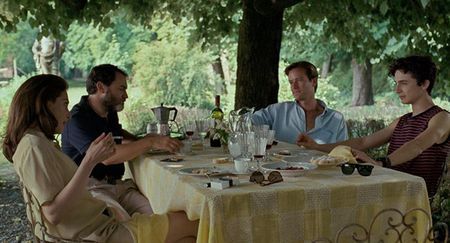
Another point I want to focus on is not the content of the movie itself, but the market and audience that the movie faces. "However, within television, audiences matter – a lot. In particular, the imagination of audiences matters because demographics determine which advertisers might be interested in shilling their wares in the spaces between the narrative" (Alfre & Martin, 2018, p.1) The film is a sophisticated work. The director has mastered his own high-speed editing and eye-catching close-up style. The rhythm of the film is very suitable for the hot Italian summer in the film. The details of the film are very special. The trust and power of the characters in the film will make ordinary audiences who are not familiar with it feel very rich. It is this kind of film craftsmanship that will let people know that the film can create resonance from an almost spiritual perspective. According to Doty (1993), "Queer" is a practiced mass culture, which is accepted and shared by different audiences to varying degrees (p.2). This film is not limited to LGBTQ groups, it is more like a movie of the same kind A new attempt to allow a more diverse audience to find a microcosm of their own life from the emotional development of the protagonist to the regretful ending. It is not only that the audience group is not defined, it is a diversified process from production to presentation. "'Queer'" can be used to describe an authorial voice, a character, a mode of textual production, and/or various types of representation practice. Filmmakers, forms, and audiences-not necessarily identified as gay or lesbian-can rather be understood as queer" (Benshoff & Griffin, 2004, p.2). As this sentence says, this movie is no longer a queer main movie in its own sense. What it wants to present to the audience is just a paragraph A beautiful and slightly regretful love story.

And in the following part, I would like to share some of my personal views and comments on the film.Before I saw this film, I only felt that the title of this film was very sentimental. Although I knew it was a story about the same sex and had won numerous awards, I was not particularly interested this time because I was disappointed in Carol first. I thought, alas, maybe another film won the award by relying on the same sex stunt.But after watching the movie, my heart was calm for a long time.Should this relationship in the movie be called sweet or regrettable?It's sweet because you have a wonderful and romantic time together.Sadly, it was clear that the relationship was not going to last, as Oliver's holiday was over and the couple were likely to be separated for the rest of their lives.Alas, sad romance ah.In the scene at the train station, the director handles it with great restraint. The two men don't even speak, just a deep hug. Then Elio smiles and watches Oliver get on the train.Elio struggled, and his grief manifested itself when he finally called home, crying and asking his mother to come pick him up.Seeing this paragraph, I already shed tears.People in love generally hope to be together all the time, but separation, often bring is tore heart crack lung pain.In the film, Elio's pain was also restrained. Maybe in front of his mother, Elio had to restrain his emotion, but because of the pain of separation, he could not cry, but could only twist his face into a lump. I have to say that the director showed the character's emotion perfectly.I want to say, Elio was still very happy, he came back home, my father said to him the meaning of a passage, it is the world 90% of the parents could not have said, he told Elio, do you have a wonderful friendship, perhaps more than friendship, you may now pain, sad, but don't let this feeling disappear, not to mention there have been happy.What a waste it is for us not to feel in order not to feel.I think it was a great comfort to Elio that their relationship was validated, that it was real, and that even though they weren't together, the joy they had would make this summer memorable.This reminds me of a sentence we learned at that time: "Het Culture think of itself as the elemental form of human Association, as the very model of inter-gender relations, as the indivisible basis of all community,And as the means of reproduction without which society wouldn't exist "(Warner, 1993, p.21).This film shows us that the beauty and simplicity of relationships should not be mixed into the so-called mission of reproduction.Love this abstract thing is unrelated to gender, just a warm attraction between two people.
"Do you mean what I think you mean?" The tone of the whole film is like these dialogues, full of ambiguity, whether day or night. Two shy people fell in love and started a classic couple life. However, there was no banquet that would never end. Oliver had to go. The night before parting, Elio saw Oliver dancing with the stranger on the road, squatting down and vomiting violently. Vomit is not only because he is unable to drink, but also because he is about to part with you. He sings and dances with strangers to his heart's content. You are like an outsider. The person you love deeply, like Mount Fuji, doesn't belong to you, and then the miserable heart quickly vomites out. The next day, the platform whistle, two people smile goodbye, the train left, take away your favorite person, you finally can't help but wipe a tear, crying in the place he can't see. At this time, he called his mother to pick her up. His mother comforted him in the car. When he got home, his father boiled chicken soup for him to drink. He felt sorry for his parents. Father's several bowls of chicken soup, the child immediately stopped crying, and even lit up hope, the professor is really not a fuel-efficient lamp. Two years later, on Hanukkah, it was winter in the small town. Frozen ponds, withered fruit trees, and heavy snow all implied the tragic fate of the hero. Elio received a phone call from Oliver, like an old friend, "I'm going to get married." then there was a classic blessing. I was numb to see. I didn't know that the screenwriter even asked Elio to say "Elio" six times. I admit that A few words almost tears, and then Oliver's soft call "Oliver", I knew the story began to point. There was a light in the eyes of the boy by the fire, but I believe he was happy at that moment because I felt the same. "Queerness is not so much a stable, clearly defined sexual orientation as it is a way of seeing and experiencing the world" (Ruberg&Phillps, 2018). This film gives me a totally different way of experiencing and seeing events. If Jack in Brokeback Mountain is warm and cheerful, and Ennis is is silent, two people forced by life fall in love on Brokeback Mountain, and eventually Yin and yang are separated. This is the real world. Then Call Me By Your Name is more like a hazy poem in the sunshine. It is a new attempt to integrate queer and the film industry. It makes people ignore the cruelty of reality and social system, and only devote themselves to the beautiful world brought by movies.

References:
1. Ahmed, S. (2006). Queer phenomenology: Orientations, objects, others. Duke University Press.
2. Doty, A. (1993). Making things perfectly queer: Interpreting mass culture. Minneapolis: University of Minnesota Press.
3. Alfred, L. & Martin, Jr. (2018). Pose(r): Ryan Murphy, Trans and Queer of Color Labor, and the Politics of Representation. LA Review of Books. URL: https://lareviewofbooks.org/article/poser-ryan-murphy-trans-queer-color-labor-politics-representation/
4. Benshoff, H. M., & Griffin, S. (Eds.). (2004). Queer cinema: The film reader. Psychology Press.
5. Warner, M., & Social Text Collective. (1993). Fear of a queer planet: Queer politics and social theory. Minneapolis, MN: University of Minnesota Press.
6. Ruberg, B., Phillips, A., Pozo, T., Stone, K., & Youngblood, J. (2018). -Queerness and Video Games Not Gay as in Happy: Queer Resistance and Video Games (Introduction). Game Studies, 18(3).
6 notes
·
View notes
Note
(sorry this is long) I'm creating a fantasy matriarchal society that's a combination of like America post WW2 and like the amazons/valkyries crossed with magical girls. I could use some help figuring out the gender dynamics, since part of my goal is to use the swap to highlight some inequalities that still exist in our gender expectations today by flipping them. I'm trying to figure out if it's better to have the men be primary caregivers (1/?)
since there’s no reason to assume that the gender that gives birth has to be the caregivers) or if I should go the “matriarchal society would value childrearing above other jobs” route. Some thoughts I had: Women are the main magic-users in society (magical girl/amazons blessed directly by the god who rules the city with power)and that perhaps all young women are expected to go through military service of some sort before becoming matrons, politicians and doctors. (2/?)
Maybe women are associated with Life and Death and “important duties” that revolve around them, including duties regarding both killing and saving lives. So healing, leading armies, fighting, hunting, childbirth (possibly care?) and politics are feminine jobs, while “lesser duties” that revolve more around menial labor are relegated to men (manual labor, maintenance, ‘uneducated’ jobs, support jobs like scribe and secretary, cooking, cleaning, perhaps some jobs like fashion design or art). (3/?)
Do you think this is a good balance? What are some other ways I could divide gender roles? The world situation is a magical land with about early 20th century level tech (trains and private schools and like phones/radios).Also, what is the best way to objectify men in this society? I was thinking of making it so men are seen as useless/only for the purpose of providing sexual pleasure and siring children to women. (4/?)
They don’t’ actually create children or take the ‘important jobs’ (the poor dears just don’t have the brains for it, they’re too simple and direct, men don’t have the emotional maturity to handle serious issues, they lack empathy, they only want sex anyway so it’s not like you need to worry about their emotional needs, etc). I’d love some suggestions on how a society like this might work or if there are other ways to divide the gender roles, (5/?)
as well as some ways men might experience objectification in society. How would fashion be different, and how would this society put pressure on men to look or act in certain ways (and women as well). Any suggestions? Thanks, and sorry for the long question(6/?)
Mod Miri Note: If you have a question that requires multiple asks, please use the google form! That way there’s no risk of parts of the question being lost.
Tex: “Do you think this is a good balance?” No, I do not. I disagree with the notion that a group of people ought to be objectified, neglected, abused, pigeon-holed, or otherwise mistreated under the guise of inversion as a way to tout a certain prescription of thought. I think this methodology perpetuates stereotypes, and with stereotypes come all the -isms that are used as excuses to treat people poorly just because they’re different from the originating group.
I’m going to be radical and say “none of the above”. There’s a few reasons for my answer, but aside from the brief overview in the previous paragraph, let me go through and try responding to all of your points in a more precise manner.
Let’s start with American culture post WWII - and I’m going to assume that, because of this choice, you’re working from an American perspective. This is important! But I’ll handle that detail in a bit.
Post-WWII culture is heavily influenced by WWII culture. For women, this meant enlistment in the military, as well as filling the gaps in the domestic labor force left by men being shipped off (History.com, The Atlantic). Their service in the military - quite often voluntary - was as critical and crucial as their domestic work (Wikipedia 1, Wikipedia 2, Wikipedia 3). They usually received lower pay than men, true (though interestingly the women in the UK were often treated better; Striking Women), though governments of the time admitted that without women the war effort would have crumpled.
Rosie the Riveter is a popular piece of propaganda (where it was also considered patriotic for women to join the workforce and military service; National Women’s History Museum), but don’t let that dissuade you from thinking that women were not recognized for other types of work during the war. Many women in the US were recognized for their military service (USO), and other women’s histories endure today - Lyudmila Pavlichenko (Wikipedia), Vitka Kempner (Wikipedia), and Virginia Hall (Wikipedia). I’m going to toss in the official synopsis of Queen Elizabeth II’s involvement in her own military to round things out (The Royal Family), complete with a picture of her in uniform (Wikipedia).
Many women after the war went back to strictly domestic duties, and I think that parallels their wartime efforts - both situations are of the “all hands on deck” type, but the play of gender roles here means that the duties of a functioning society are divvied up by different functional spheres - and make no mistake, men and women relied on each other equally as much to cover the gaps, despite the sexism inherent in modern Western society. The difference between war and non-war time cultures was that the latter wasn’t necessarily cultivated by patriotism that could unite the different “factions”. The Oxford Research Encyclopedia of American History gives a thorough examination of this topic.
The following era - typified by the birth of the Baby Boomer generation - saw a marked increase in economic prosperity (Wikipedia). With that came increased social mobility for women (Citation 1), usually catalyzed by the actions of their fathers (Citation 2). This may typically be achieved by consistent, conscientious public policy formation (Citation 3). In short, many cultures - if they haven’t already - are realizing that it’s good for business to let women control how they participate in society and the flow of money.
In the US, this was precipitated by the boom of social development (American History; archived version). Aside from the Truman administration negotiating price fixing to prevent inflation, a significant factor was the passing of the Servicemen’s Readjustment Act of 1944 (AKA the G.I. Bill). This primarily benefited the Greatest Generation, though other pertinent legislation by the 79th Congress benefited the Silent Generation onwards: the Fair Deal, Revenue Act of 1948, Taft-Hartley Act, Employment Act of 1946, National School Lunch Act, and Hobbs Act.
It’s debatable how well this impacted long-term economic development, considering the almost immediate rise of McCarthyism in the US in 1947, which was heavily intertwined with the Truman Doctrine that precipitated the Cold War. The results of the war, at least economically, were… mixed (Wikipedia 1, Wikipedia 2). I have no doubt that this impacted the social mobility of women in all affected countries - which is all of them, but I’m sure hairs could be split on this if you wish.
Now that we’ve got that out of the way, let’s tackle the Amazons.
The modern, popular interpretation (that is slow to be shaken by archaeological evidence) is mostly mythological (Wikipedia). While some ideas are thrown in the way of a Minoan Crete ancestry to the myth, there are more similarities drawn to the Scythian and Samartian cultures on the Eurasian Steppe (CNET). It’s possible that instead of the equally-extreme pole end of the gender dichotomy that is patriarchy-matriarchy, the Scythians just scandalized the Athenians with a comparatively more fluid society (Smithsonian Magazine).
As for Valkyries… there’s been a revival of them in pop culture, probably as a net-casting to see what’s out there aside from Amazons. TVTropes covers the many, many ways media utilizes them as a trope, to varying degrees of mythological and cultural accuracy. As they state, valkyries are a form of psychopomp, as they decide who among the battlefield’s dead will go to Valhalla (ruled by Odin) or Fólkvangr (ruled by Freya). Freya seems to have assumed the “type” (as opposed to characteristics salient to a particular individual) of a valkyrie, as the female counterpart the warrior archetype. To wit, Freya herself may be a type (Wikipedia).
Here’s where the issue gets thorny - modern popular understanding of valkyries, and by extension Scandinavian women, is skewed through the modern lens.
@fjorn-the-skald has a lovely series called Viking History: Post-by-Post, or An Informal Crash Course & A Historical Guide to the Vikings, that typically focuses on medieval Iceland. In his post “Lesson 13.c - Women in the Viking Age, Part III: Were Women “Vikings”?”, discusses the particular penchant of modern times to romanticize and/or skew history to their own biases - in this instance, how medieval Icelandic women functioned in their culture, as well as how valkyrie myths play into this.
The TL;DR of that is: “viking” women were a societal anomaly, the battlefield was a male domain (and they were expected to die on it), a woman’s prowess of the domestic sphere was highly respected to a level often equivalent to men, and the domestic sphere was the sphere of commerce. Scandinavian culture prized strong women, just as they prized strong men, and their culture rested upon the concept of different genders having their own distinct, complementary, and equal domains.
Fjörn builds upon this history in an ask about gender roles outside the usual dichotomy of male-female. Valkyries, and shield-maidens, may be classed as a third gender in medieval Scandinavian culture, because women were temporarily occupying the male role in their society. While valkyries are of divine origin, shield-maidens are not, though they seem to have taken on a supernatural bent by performing feminine qualities while living in the male sphere (something that they can literally wear, by the donning of their armor).
That probably comes across as distasteful to, especially, a modern American perspective, but many ancient cultures are like that. There’s a footnote on that ask about links to a contemporary perspective of same-sex relationships, as well, to round out that talking point.
With those historical and mythological details discussed, let’s move on to magical girls.
Interestingly, the genre and trope derive from the American TV show Bewitched (Nippon.com). Its evolution reflected Japan’s changing tone about female sexuality, focusing on girls. Magical Girl doesn’t seem to be intended to attract the male gaze in a sexual light - and in fact was generated as a form of female empowerment by by way of growing up (TVTropes), but it seems to happen anyways (TVTropes).
Magical girls, as a genre, originated in the 1960s - the archetypical Sailor Moon encompasses not only magical girls, but also the kawaii aesthetic. Kawaii, incidentally, followed after the magical girl trope, and plays upon women performing as girls in society.
As magical girls are intended for young girls, a demographic known as shōjo, it is considered a subgenre of the target audience. Please note that shōnen'ai (Fanlore) and yaoi (Fanlore) are also subgenres of shōjo.
For some context, the adult female target audience is known as josei, the young adult men is known as shōnen, and adult male audience is known as seinen. Many manga and anime are often misattributed to the wrong category, so it helps to know which is which, and why.
Kumiko Saito argues (through an unfortunately paywalled article that I’m more than willing to disseminate to those without JSTOR access) that magical girls reinforce gender stereotypes as well as fetishize young female bodies. She argues this point more eloquently than I can, so I’ll be quoting a few sections below.
Page 148 (7 of 23 on the PDF):
The 1960s “witch” housewife theme waned quickly in the United States, but various cultural symbolisms of magic smoothly translated into the Japanese climate, leading to Japans four-decade-long obsession with the magical girl. Bewitched incorporated the concept of magic as female power to be renounced after marriage, thereby providing “a discursive site in which feminism (as female power) and femininity has been negotiated” (Moseley 2002, 403) in the dawning of Americas feminist era. Japans magical girls represented a similar impasse of fitting into female domesticity, continued to fascinate Japanese society, and came to define the magical girl genre. In direct contrast to the American heroines Samantha and Jeannie, however, whose strife arose from the antagonism between magic (as power) and the traditional gender role as wife or fiancée, the magical girls dilemma usually lies between female adulthood and the juvenile female stage prior to marriage, called shõjo. In other words, the magical girl narratives often revolve around the magical freedom of adolescence prior to the gendered stage of marriage and motherhood, suggesting the difficulty of imagining elements of power and defiance beyond the point of marriage. In fact, these programs were broadcast exactly when the rate of love-based marriage started to surpass that of miai (arranged marriage),4 which implies that the magical girl anime, founded on the strict ideological division between shõjo and wife/mother, may have been an anxious reaction to the emergent phase of romance.
Page 150 (9 of 23 on the PDF):
The combination of magical empowerment and shõjo-ness framed by the doomed nature of transient girlhood naturally created ambivalent, messages in Akko-chan as well. In the societal milieu in which Japan was undergoing the politically turbulent era of Marxist student movements at the largest scale in the postwar era, Akko-chan’s super- human ability to transform into anyone (or anything) is quite revolutionary, implying a sense of women’s liberation. Despite this potential, her metamorphic ability never threatens gender models, as she typically dreams of becoming a princess, a bride, or a female teacher she respects. The use of magic is also largely limited to humanitarian community services in town. Akko-chan’s symbolic task throughout the series focuses on how to steer her power to serve her friends and family, leading to the final episode in which she relinquishes magic to save her father. Akko-chan embraces the cross-generic mismatch between the radical idea of empowering a girl with superhuman ability and the hahamono [mother genre] sentimentalism idealizing women’s self-sacrifice. All in all, the new setting adopted in this series, that a mediocre girl accidentally gains magic, became a useful mechanism for the underlying theme that the heroine is foredoomed to say farewell to magic in the end. This rhetorical device transforms latent power of the amorphous girl into the reappreciation of traditional gender norms by equating magic with shõjo-hood to be given up at a certain stage.
Saito discusses the thematic shifts in the magical girl subgenre in the 1980s to a more sexualized view, and the according rise of both an older audience and otaku fans, the latter of whom, she clarifies, make a habit of recontextualizing canon to categorize characters into stereotypes that are stripped of the majority of their original context.
On pages 153-154 (12-13 of 23 on the PDF):
The conventions of the magical girl genre transformed significantly against this paradigm shift. Both Minky Momo and Creamy Mami originally targeted children, recording a decent outcome in business and eventually leading to the revival of the genre. Because the plots are directly built on the genre clichés, however, the jokes and sarcasm of many episodes appear comprehensible only to adult viewers equipped with the knowledge of the Töei magical girls. The intrigue of these programs largely lies in the way they parody and mock the established genre conventions, especially the restrictive function of magic and the meaning of transformation. The genre is now founded on the expectation that the adult viewer has acquired a diachronic fan perspective to fetishize both the characters and the text’s meanings.
Creamy Mami presents the story of fourth-grader Yū, who gains magical power that enables her to turn into a sixteen-year-old girl. Yū’s magical power is more restrictive than Momo’s, for her superhuman capacity simply means metamorphosis into her adult form, who happens to become an idol singer called Mami. Given that the magic’s ability is self-oriented cosmetic effect and bodily maturation, the heroine’s ultimate goal by means of magic is to grow old enough to attract her male friend Toshio, who neglects Yū’s latent charm but falls in love with the idol Mami. The series concludes when Yū loses her magic, which correlates to Toshio’s realization that Yū is his real love. Mami’s thematic messages teach the idea that magic does not bring much advantage or power after all, or rather, magic serves as an obstacle for the appreciation of the truly magical period called shõjo. The heroine gains magic to prove, although retroactively, the importance of adolescence preceding the possession of “magic” that enables (and forces) female maturation.
It’s noted in the article that the 1990s-2000s period received criticism for showing a physical maturation of girls, so codified euphemisms via garment changes such as additional frills and curled hair were used instead. This “third-wave” magical girl challenged standing norms of its predecessors by doing things such as likening adult responsibilities (“childrearing and job training”) as a sort of game, as well as the transformation implying that the character’s power is in being herself, something that juxtaposes previous norms.
Due to shifting power dynamics and other changes in Japan’s culture, it became more common for boys to become magical girls as well, further separating the magical girl concept from a strict reflection of gender roles. As such, Japanese culture - insofar as my English-based research can guide me - no longer immediately implies a direct and distinct correlation between magical girls and the female gender.
An analysis of Puella Magi Madoka Magica (PMMM) by Tate James (2017; PDF) discusses an additional dimension of the magical girl genre. Two pertinent points of the piece is that 1.) PMMM dismantles archetypes pitting women against girls, and 2.) PMMM reinforces the gender stereotype that the best type of girl is a passive girl.
Now for the issue you’ve raised about who ought to be the primary caregiver of children.
Consistent, immediate, and continuous interaction between a mother and her child benefits both of them (Citation 4, Scientific American 1, Live Science, Citation 5, Scientific American 2, UNICEF, WHO). Mothers have a distinct neurobiological makeup that predisposes them toward caring for infants (Citation 6), and likewise infants have a predisposed preference to their mother’s voice and heartbeat (Citation 7). I would like to think that is sufficient evidence as to why nearly all cultures encourage mothers as the primary caregivers.
This said, cultivation of a father-child dyad is immensely beneficial to the child (Citation 8, Citation 9), and can alleviate the effect of maternal depression on the child (ScienceDaily). Partnered men residing with children have lower levels of testosterone but a higher risk of cardiovascular disease and adiposity (Citation 10). It’s interesting to note that higher prolactin levels in the mother’s breastmilk has a correspondingly higher level of sociosexual activity with their partner in cotton-top tamarins, which stimulates pair bonding (Citation 11), as well as in other species (Citation 12).
Paternal postpartum depression is recently recognized in fathers, to severe and reverberating deleterious effects on themselves and their family (Citation 13). Screening tools for detecting depression in Swedish fathers is not sufficiently developed, and many men may be passed over despite reaching cut-off suggestions in other criteria for depression (Citation 14).
It has been observed that while human mother and fathers have the similar oxytocin pathways, the exhibit different parenting behaviours when exposed to elevated levels of oxytocin - primarily that fathers will react with high stimulatory behaviour and exploratory play (Wikipedia).
Men being socialized in a culture of stoicism and an encouraged reaction pattern to violence have poor mental health that can culminate into death and other long-term effects (Citation 15). Suicide in the US is currently the leading cause of death at time of posting this response, that the total suicide rate increased 31% from 2001-2017, and in 2017 male rates were nearly four times higher than females (NIMH).
On the topic of magical culture: it’s incredibly difficult to research because it’s a component of overall culture, and one that’s not typically available to strangers/foreigners/the uninitiated. As such, a lot of authors default to what they already know. It’s not a bad thing, but if someone wants to reach outside their comfort zone, they’re going to have some trouble.
I’m going to go off the three, four-ish, cultures you’ve already come to us with: American, Scandinavian, Scythian/Samartian, and Japanese just to round things out.
For a very, very rough overview of America, we have:
Native Americans of the contiguous US
Hawai’i
Alaska
Whatever the colonizing peoples brought over (including, but not limited to, English, Scottish, Irish, Norwegian, German, and Italian)
Whatever the myriad cultures of Africa brought over as slaves
Hispanic
NB: I’ve put Hawai’i and Alaska as separate items because they’re not part of the contiguous US.
European settlers were of a few groups:
The merchants working on charters
Indentured servants from the merchants’ homelands
Slavs
Immigrants in post-colonial eras
This is an important distinction because 1.) contemporary culture matters a lot politically, 2.) how people came to the US determined how they and their family were treated, and 3.) the contemporary job culture determined their social class.
(Slavs, as a note, are the origin of the English word “slave”, something that Western Europeans historically liked to propagate.)
I’m not going to go into the details of everything the US has to offer in terms of cultural diversity aside from a nudge in the direction of Santería. What you pick up to research is up to you.
Scandinavian folk magic is known as “trolldom” (Swedish-language Wikipedia), and the region was known for their cunningfolk. Please note that klok/-a, klog/-e, and related words relates to the English word cloak, and these people are so named because wearing one was an integral part of how they interacted with the supernatural.
The InternetArchive has a book (albeit in Swedish) about the history of magic in Sweden, which is available in multiple formats. If you’d prefer to have something in English, you can either buy this book, or inform your library you’d like to them to buy it for you.
I’m a little surprised you hadn’t mentioned either the völva (Swedish Wikipedia, English Wikipedia) or seiðr (Wikipedia), as they’re quite a well-known part of Scandinavian folk culture. Fjörn, as always, is my first stop for this area of research, with the post “Lesson 7 - Viking Spirituality”, the Víkingabók Database, the tag of Old Norse words, and the post “Norðurbók: A List of the Tales and Sagas of Icelanders” as incredibly good starting points. I encourage you to peruse them, especially because the words you learn will help you be more precise during research.
The Scythian culture is quite far reaching, as they had occupied most of the Eurasian Steppe during the Iron Age, and much of this area can be found in modern-day countries such as Russia, Iran, and China, among others. Because of how far their peoples spread out, the Scythians intermixed with their neighbors, and as such there are sub-groups to the culture.
The Sarmatians were more Russian, as that’s where a large amount of their territory laid, and were absorbed into early Slavic culture. Both their and the overall Scythian language group is eastern Iranian.
In order to help you orient yourself, here’s a map from Wikipedia:

Description: Historical spread of Iranian peoples/languages: Scythia, Sarmatia, Bactria and the Parthian Empire in about 170 BC (evidently before the Yuezhi invaded Bactria). Modern political boundaries are shown to facilitate orientation.
Japanese magical culture is intrinsically tied to their religion, and as such it would be beneficial to read about Shintoism and Japanese Buddhism. The wiki for Japanese mythology is a thorough primer, though if you get stuck, then I’m sure @scriptmyth would be glad to help you on not only this culture, but others.
As for the jobs you’ve proposed - I’m going to jump right into scribes because the irony of that is it’s historically a male-dominated job, and is the progenitor of jobs such as “public servants, journalists, accountants, bookkeepers, typists, and lawyers”. It is, with even greater irony, European women that are noted in Wikipedia, and that medieval women are increasingly thought to have played an integral part in manuscript writing (New Scientist, Science Advances).
I’m not the best person to ask for medieval culture, unfortunately, so you’ll need someone more knowledgeable than me on the subject to direct you to the finer points.
The wiki for women in war links to a lot of lists, so I would suggest poking around for historical references by era (that will likely lead to by culture) to orient yourself on how women have participated in war in the past. There’s quite a bit of mythology to be found there, as well, so if you pick up some specific goddesses you get stuck on, then pop over to @scriptmyth.
Likewise, the wiki for women in government is an interesting read, as is women in positions of power. Since both are primarily modern-times oriented, I would suggest looking at the list of queens regnant for a more historical perspective. I would have difficulty giving you more than that, as you would need to pinpoint your reference cultures first.
As history often neglects women’s contributions to society if they weren’t a ruler or similarly powerful ruler - and, frankly, that frequently applied to men as well the further back you go - I’m going to toss a couple of starting points at you for the area of medicine:
Women in medicine § Ancient medicine - Wikipedia
Women in medicine - Science Museum: History of Medicine
One thing to keep in mind is that as goalposts changed for medicine - the standardization of knowledge and the need to attend a medical school to be legally allowed to perform medicine - the availability of women to participate went down.
Another is that medicine, historically, relied upon herbal medicine, and Wikipedia itself notes that there’s a heavy overlap with food history - something that’s traditionally a domain of women. This abstract by Marcia Ramos‐e‐Silva MD, PhD, talks about Saint Hildegard von Bingen, and the first page available tells you that medieval women were in charge of quite a lot despite not being allowed to participate in the male-dominated sphere of war. The Herbal Academy dips briefly into not only the saint, but other historical aspects of herbalism that might interest you.
The wiki of women in the Middle Ages, along with that of Hildegard of Bingen, nicely rounds out this particular topic.
I need to bring out the fact that Ancient Egypt was and is well-known for the equality and respect afforded to their women - in the interest of staying on subject, particularly in the field of medicine (Ancient History Encyclopedia). Isis was well-known as a goddess of healing (Wikipedia), an aspect she has in common with goddesses in many other cultures (Wikipedia). As an added side-note, Merit Ptah in her popularly-known context has been concluded to be an inflated misunderstanding - and misconstrued interpretation - of a historical figure with significant fabrication (LiveScience, Oxford).
The presence of women in medicine fluctuated in every culture, an in ancient times often shared some correlation with the use of magic (Citation 16). Healing, historically, has a high correlation with the supernatural - and if you care to look, women are usually responsible for the domain of the supernatural. (Or at least the feminine part, which was complementary and complemented by the masculine part.)
I’m going to hop back to politics real quick to bring up abbesses, particularly the social power they exercised as women heading religious orders. An article by Alixe Bovey for the British Library gives the TL;DR of medieval women and abbeys, though if you’d like something with a bit more detail, Medieval English Nunneries c. 1275 to 1535 by Eileen Edna Power is also available.
Abbeys, with their rise and fall, are important to modern American culture. Midwives, to be even more particular, have the most direct impact. In Western Europe, a midwife may under certain circumstances perform baptisms. This was a debated topic of its time, as baptisms were rituals of the Church, and the Church had strict regulations allowing only men to perform their rituals.
During the 1500s - and up to the 1800s, in some cases - midwives were defamed to be witches. You’ll notice that this corresponds to a standardization of medical knowledge, with its corresponding legal restrictions on who may practice medicine. For the Church, the politics playing behind the scenes of midwifery and female physicians fluctuated with their observations about women’s power relative to their own (Citation 16).
Malta is an excellent case study of this phenomenon (Citation 17), and encapsulates the movement of witchcraft accusations that took place throughout this period - something historians noted as corresponding to the rise of Protestantism (ThoughtCo). There’s some debate that the increasing orientation to wages in contemporary economy facilitated this adverse behaviour against women, as well as various other social pressures as politically mitigated by the Catholic Church (Wikipedia).
As the practice of medicine was segregated according to sex - male patients to male physicians, female patients to female physicians - there were proportionally fewer men in trades such as midwifery than women despite the medieval shift toward male encroachment of territory (Wikipedia). This corresponding money- and thus male-oriented intrusion into the female sphere of medicine can be seen with the invention of the obstetric forceps (JSTOR). The rising culture of appropriation constituted the witchcraft trials that, incidentally, influenced American culture during their colonization years.
A pertinent name to remember for American history of the witchcraft trials is Margaret Jones, a Puritan midwife and the first person to be accused of witchcraft in the trails taking place in the Massachusetts Bay Colony (Wikipedia).
The Salem Witch Trials, as an offhand note, could well be an anomaly due to ergotism (Citation 18).
One thing I’m willing to bend on - a little bit - is manual labor, but mostly because you’re describing something very similar to what’s already been invented: corvée labor. There’s plenty of other forms depending on what culture you’re going for, though unlike what you’re proposing, does not necessarily imply the direct and permanent subjugation of people.
I will absolutely quibble with the idea of “uneducated” labor equating to “less valuable” labor - universities offer non-vocational degrees, typically in the areas of research and/or religion, and guilds were created as a means of quality control (that unfortunately got out of hand and committed crimes such as rent-seeking). Women in guilds were a thing, vulnerable to the same fluctuations as their other occupations outside the house.
If we are defining “uneducated” labour as “menial” labour, then this set of occupations inherently varies by culture, as does its relative weight of importance. One example of this would be writing; it may be menial but important, whereas holding negotiations could be a “major” role but wouldn’t exist without the support of workers “less than” them.
Correspondingly, gender divisions may not necessarily mean an assignation of “lesser” or “greater” when compared against each other. In medieval Europe, at least, the creation of textiles was split along the general lines of spinning and weaving. Women held the former (hence “spinster”), and men held the latter. Spinning was often not formalized into guilds then, but it was an important cornerstone of the economy that could support entire families. A guest post on The Freelance History Writer’s blog seems to indicate that this gender division was due to influence by the Bible, which seems to corroborate with the history of both professions as detailed on Wikipedia - the further back we go, and also the less connected to Christianity, the more textile work women presided over. This granted them greater control over their presence in society, since the selling of textiles was useful leverage to support themselves and others.
A similar discrepancy can be found with agriculture. Hamer women in Ethiopia are traditionally the one to cultivate sorghum, a cornerstone crop to their diet, and they exhibit preferences in which varieties they grow according to criteria such as which is easiest to grind and long-term storage feasibility (Citation 19). Accordingly, there’s been an increasing orientation around the growing of crops rather than the pastoralist habits of their men, with trading standards occuring at one goat for one Dore (“pile of maize or sorghum”) (Citation 19).
A study examining the male sphere of hunting within a society discusses the various cultural implications of defendable vs non-defendable meat sharing, with respect to how the meat is distributed and its corresponding social range (e.g. immediate social circle vs entire community), something I find interesting given that the kilocalories obtained from meat is roughly equal to that of the female sphere-acquired agriculture/gathering (Citation 20). The division of labour along gender lines when it comes to food flow in a community seems, historically, to be both comparable and compatible to each other - a recurring theme with many of the topics I’ve already covered.
Gender roles in their historical perspective - especially the further back you go - are often complimentary to each other, and are an economical way to divide up the burden of maintaining a society to a functional level. There are plenty of exceptions to this (see: third genders), as well, and many cultures exhibit the idea that a productive person is good for society; their roles may look a little different from the person next to them, and not only is the work considered equal in terms of importance, but also with a bit of poking around, you’ll find that few cultures have harsh punishments for anyone “stepping outside” their predicted roles.
Men are already objectified plenty. That their treatment by society looks different than women’s, or other genders, is by no means an excuse to sweep things under the room and pretend that they have it best - or worse, purposefully ostracize them in a fictional work to further mock, ridicule, and isolate them. This contributes to the societal issues in your culture that you wish to address, and stems from a uniquely pervasive perspective from modern American culture that differs from many other cultures in the world.
TL;DR - The way you wish to objectify men is already being done, especially in American culture. It is harmful, and will have an impact that will reach further than you might anticipate. This approach is counterproductive to your goals, and the cultures/media you cite either directly contradict your beliefs of said sources or otherwise undermine your beliefs. It is vastly more productive to take a deeper look at the origins of the issues you wish to address in your writing, as well as the reference material that you wish to use. Learning perspectives outside your native culture will benefit you immensely, and the results could surprise you.
Citations
Citation 1 - PDF - Doepke, M., Tertilt, M., Voena, A.. (2012). “The Economics and Politics of Women’s Rights,” Annual Review of Economics, Annual Reviews, vol. 4(1), pages 339-372, 07.
Citation 2 - PDF - Fernández, R.. (2014). “Women’s rights and development,” Journal of Economic Growth, vol 19(1), pages 37-80.
Citation 3 - PDF - Duflo, E. (2012). “Women’s Empowerment and Economic Development”, Journal of Economic Literature, Vol. 50, No. 4: 1051-79.
Citation 4 - PDF - Crenshaw J. T. (2014). “Healthy Birth Practice #6: Keep Mother and Baby Together- It’s Best for Mother, Baby, and Breastfeeding.” The Journal of perinatal education, 23(4), 211–217. doi:10.1891/1058-1243.23.4.211
Citation 5 - Faisal-Cury, A., Bertazzi Levy, R., Kontos, A., Tabb, K., & Matijasevich, A. (2019). “Postpartum bonding at the beginning of the second year of child’s life: the role of postpartum depression and early bonding impairment.” Journal of Psychosomatic Obstetrics & Gynecology, 1-7.
Citation 6 - PDF - Bornstein, M. H., Putnick, D. L., Rigo, P., Esposito, G., Swain, J. E., Suwalsky, J. T., … & De Pisapia, N. (2017). “Neurobiology of culturally common maternal responses to infant cry.” Proceedings of the National Academy of Sciences, 114(45), E9465-E9473.
Citation 7 - PDF - Webb, A. R., Heller, H. T., Benson, C. B., & Lahav, A. (2015). “Mother’s voice and heartbeat sounds elicit auditory plasticity in the human brain before full gestation.” Proceedings of the National Academy of Sciences, 112(10), 3152-3157.
Citation 8 - PDF - Pan, Y., Zhang, D., Liu, Y., Ran, G., & Teng, Z. (2016). “Different effects of paternal and maternal attachment on psychological health among Chinese secondary school students.” Journal of Child and Family Studies, 25(10), 2998-3008.
Citation 9 - PDF - Brown, G. L., Mangelsdorf, S. C., & Neff, C. (2012). “Father involvement, paternal sensitivity, and father-child attachment security in the first 3 years.” Journal of family psychology : JFP : journal of the Division of Family Psychology of the American Psychological Association (Division 43), 26(3), 421–430. doi:10.1037/a0027836
Citation 10 - PDF - Lee T Gettler, Mallika S Sarma, Rieti G Gengo, Rahul C Oka, James J McKenna, Adiposity, CVD risk factors and testosterone: Variation by partnering status and residence with children in US men, Evolution, Medicine, and Public Health, Volume 2017, Issue 1, January 2017, Pages 67–80, https://doi.org/10.1093/emph/eox005
Citation 11 - PDF - Snowdon, C. T., & Ziegler, T. E. (2015). “Variation in prolactin is related to variation in sexual behavior and contact affiliation.” PloS one, 10(3), e0120650.
Citation 12 - Hashemian, F., Shafigh, F., & Roohi, E. (2016). “Regulatory role of prolactin in paternal behavior in male parents: A narrative review.” Journal of postgraduate medicine, 62(3), 182–187. doi:10.4103/0022-3859.186389
Citation 13 - PDF - Eddy, B., Poll, V., Whiting, J., & Clevesy, M. (2019). “Forgotten Fathers: Postpartum Depression in Men.” Journal of Family Issues, 40(8), 1001-1017.
Citation 14 - PDF - Psouni, E., Agebjörn, J., & Linder, H. (2017). “Symptoms of depression in Swedish fathers in the postnatal period and development of a screening tool.” Scandinavian journal of psychology, 58(6), 485-496.
Citation 15 - Pappas, S. (2018, January). “APA issues first-ever guidelines for practice with men and boys.” Monitor on Psychology, 50(1).
Citation 16 - PDF - Kontoyannis, M., & Katsetos, C. (2011). “Midwives in early modern Europe (1400-1800).” Health Science Journal, 5(1), 31.
Citation 17 - PDF - Savona-Ventura, C. (1995). “The influence of the Roman Catholic Church on midwifery practice in Malta.” Medical history, 39(1), 18-34.
Citation 18 - PDF - Woolf, Alan. (2000). “Witchcraft or Mycotoxin? The Salem Witch Trials. Journal of toxicology.” Clinical toxicology. 38. 457-60. 10.1081/CLT-100100958.
Citation 19 - PDF - Samuel, T. (2013). “From cattle herding to sedentary agriculture: the role of hamer women in the transition.” African Study Monographs, Suppl. 46: 121–133. [Alternate PDF link]
Citation 20 - PDF - Gurven, Michael & Hill, Kim. (2009). “Why Do Men Hunt?.” Current Anthropology. 50. 51-74. 10.1086/595620.
Further Reading
Harry S Truman § Domestic Affairs - Wikipedia
Marshall Plan - Wikipedia
Interstate Highway System - Wikipedia
Medieval Icelandic Law (The Grágás) – Women’s Rights: On Reclaiming Property during Separation. By @fjorn-the-skald
Fjörn’s Library
“Notes on Valkyries and the like?” by @fjorn-the-skald
Fjörn’s chronological tag on women
Epigenetic correlates of neonatal contact in humans - Development and Psychopathology
Feral: So, obviously, everything Tex just said- round of effing applause!
I do want to hone in on one specific part of your ask, “since part of my goal is to use the swap to highlight some inequalities that still exist in our gender expectations today by flipping them” and direct you to this blog post on Mythcreants specifically addressing the Persecution Flip Story and why it’s not a great idea from a social justice perspective.
Happy reading!
47 notes
·
View notes
Text
Bisclavret Round-Up
Unholy took about three months to write. Fairy Tale took five. Hindsight took six.
Bisclavret took nineteen, and that should be the biggest indicator to you that I didn’t know what the hell I was doing.
This was my first venture into another fandom, and out of my comfort zone (though not entirely – supernatural elements for life). I’m not sure whether or not I did the source material and its characters justice, however, especially with the supernatural element I went with (Wolves are believed to have gone extinct in England in the late fifteenth or early sixteenth century), but I will try to explain my reasoning behind some of my decisions here.
The Characters
My main concern.
We get a good view of Monty’s thought process throughout the show, through the framing device of writing his memoirs and views of his private affairs. Phoebe and Sibella, on the other hand, are characters we don’t get much of in the way of examination – we only see them through Monty’s eyes until the very end, where they reveal themselves as more than that.
Sibella is a bit self-centred, and extremely practical when it comes to how she sees her place in society, which implies some self-confidence issues. Phoebe is more idealistic, and independent, but still hopes for a match fit for a storybook. But, towards the end, Sibella demonstrates she is more than a vain god-digger, afraid of losing the man she loves and willing to potentially compromise her image to save him, while Phoebe shows that she is not nearly as innocent or naive as the people around her consider her to be.
I interpreted the two women’s characterisations as thus; Sibella believes she is bound by society’s view of her. Phoebe does not. This, I believed, needed to be the focus.
Which is where we introduce…
The Whole Werewolf Thing
“[Post-modern Gothic] warns us to be suspicious of monster hunters, monster makers, and above all, discourses invested in purity and innocence. The monster always represents the disruption of categories, the destruction of boundaries, and the presence of impurities and so we need monsters and we need to recognize and celebrate our own monstrosities.” - J Halberstam, Skin Shows: Gothic Horror and the Technology of Monsters
I gave a number of possible causes of the D’Ysquith ‘family curse’, if it is one – the actions of the first countess, Gregory D’Ysquith burning down a monastery (divine punishment is a possible cause), but I never gave a specific answer. I think I might be operating on the logic of the original Bisclavret – it’s irrelevant.
The reason there isn’t is because I intended it as a metaphor – which I think I’ve made clear with my chapter updates here (though you don’t have to read it that way, Death of the Author and all that), but I never quite decided and what it was a metaphor for. In terms of this particular narrative, it can be read as a metaphor for feminism, and/or a metaphor for same-sex attraction.
Feminism
Edwardian Era England, where A Gentleman’s Guide takes place, is not overly-represented in fiction. Not surprising, considering it’s a pretty short time period between the surprisingly long Victorian era and the world-changing events of World War One. However, when you think of that time period, a certain group tends to come to mind – the suffragettes.
(Just a note. Agatha D’Ascoyne, the character from Kind Hearts and Coronets who inspired Hyacinth D’Ysquith in the musical, was a suffragette. She has no lines, apart from “Shush!” – Deeds, Not Words.)
We know what these people wanted – Votes for Women. They were not prepared to wait for society to change to get it, and when peaceful protest was ignored, they began to act out. They refused to fit into their role of quiet, demure, loyal wives, and for some groups, this was seen as threatening. Anti-suffragette cartoons of the time often depicted these women as old, ugly and/or selfish for wanting similar rights to men instead of accepting their place as a ‘lesser being’.
The point I am trying to make is, being in defiance of the role you are expected to play – which Sibella is afraid to show – was seen by many to be ugly. Beastly.
Phoebe runs Henry’s country estate for him. Phoebe flaunts societal expectations by proposing to Monty, instead of waiting for him to propose, the ‘proper’ way to do things. While she is feminine, she does not fit the idea of what a woman ‘should be’.
Sibella makes a point to meet her obligations as a wife, though she does surreptitiously carry on an affair. She sacrifices her own happiness to get what she wants in a socially acceptable way. She has no intention of leaving Lionel in the source material, but she convinces herself that a rich, good-looking, polite man – what society thinks of as the ideal male – is what she wants, and realises on her wedding day that it isn’t.
And goes through with it anyway.
When she can no longer fit that mould, when she refuses to go along with Lionel’s plan to leech off the countess, when she undermines and argues with her husband, that’s when things start happening. Indeed, her ‘beastly’ outbursts manifest as standing up for herself. She ends the story as a much happier and self-assured person than she was at the beginning, and attempts to bring justice to other women.
Same-Sex Attraction
This is a bit more straightforward. We’re coming right off the back of the Victorian era here, where Oscar Wilde and others like him got their lives ruined. Same-sex relationships aren’t viewed in a positive light at all at this time – you like the same gender? Off to prison with you, deviant!
As people that were (and often still are) villainised, misunderstood and attacked for the crime of existing, some members of the LGBT community reclaim monsters such as vampires, werewolves and the Babadook as their own as a means of subverting their image in a heteronormative society. Being ‘monstrous’ is not bad. Being different is fine. You may feel malformed and wrong, but you are not. You and your quirks are accepted.
For some, the ones to fear are those who appear in the daylight.
Sibella, for all her talk of being a monster, only fights back when threatened. Morton has a heart attack when put in the position of his victims, subverting the formula he’s used to. Lionel, fearing that Sibella will leave him and damage his image, resorts to violence against Sibella and several other women he sees as substitutes for her. Mary attempts to murder Sibella for getting in the way of a monogamous man-woman relationship. In her eyes, Sibella is an irredeemable villain, but Phoebe can be ‘fixed’.
If you want to look deeper into this link between horror and the LGBT community, here’s a video essay discussing gay, lesbian, bisexual and transgender representation in horror films.
There are only a few non-metaphorical references to werewolves. The wolf head in Eugenia’s dower house is a family member – as previously mentioned, wolves went extinct in England during the reign of Henry VII. St Hubert’s Key is a charm that more often than not looks like a nail, and was supposed to be able to rid the body of disease caused by a dog or wolf bite. There is some science behind this – the metal was heated before being pressed to the wound, and, if the subject was at risk of contracting rabies from the injury, the heat would likely sterilise and cauterise the potential infection site.
Not the First Murder-y Heir
There are a couple of characters named or directly taken from Israel Rank – Autobiography of a Criminal, the inspiration for Kind Hearts and Coronets and A Gentleman’s Guide to Love and Murder. I’ve compared these works before, so I’ll just go over those that appear here.
Esther (Lane) – The third object of Israel Rank’s affections, and a governess. Knows more than she’s letting on in Israel Rank, and in this story as well.
James “Jim” Morton – Appears for about a page to explain Israel’s disillusionment with the ideal male – while Morton seems great to some, he really isn’t. Since Jim only appears as a child in the book, his characterisation here is drastically different.
Lord and Lady Pebworth – Almost directly lifted from the book, with Lady Pebworth being a bad singer and Lord Pebworth an older gentleman who lets his wife get away with a lot. The difference here is that Israel introduces the Hollands to the Pebworths, while the Pebworths are hoping the Hollands introduce them to Lord and Lady Navarro.
Sir Anthony Cross – Quiet, very well-off, slightly older gentleman who is quite taken by Sibella, but it doesn’t go anywhere. Acquaintance of the Pebworths. Pretty much the same guy.
Ethel D’Ysquith (Gascoyne) – An ancestor Israel is quite taken with, not only due to the resemblance between the two. He’s made the 3rd Earl of Highhurst because I didn’t feel like making an imaginary preceding title (Monty is only the 9th Earl, while the 10th Earl Gascoyne is about five generations before Israel – Ethel was the 6th Earl) and the 2nd Earl, Roland, had already been named in the musical. Phoebe’s description of him is meant to heavily imply he was also a werewolf. If I had read the book before fleshing out the D’Ysquith family tree, he would have taken the role that the first countess plays in the narrative’s events (Ethel Gascoyne hid in a tower with an Italian magician for 20 years).
Kate Falconer – The character who would later be known as ‘Boat Girl’ in Kind Hearts and Coronets and Evangeline Barley in A Gentleman’s Guide. Her great crime is to go on holiday with her boyfriend, and gets poisoned for her troubles. She survives here, and I used her to try a formatting technique (while she speaks, none of her dialogue is in quotes: in a way, she is voiceless).
(Sir) Cheveley Drummond, (Lady) Enid Branksome, and Catherine Goodsall – only mentioned briefly. Drummond is described as handsome and ‘interesting’ by Israel, Lady Enid is a young woman from a penniless but aristocratic family, and Catherine Goodsall in an actress whose abusive husband was beaten so badly by a Gascoyne he joined the navy and never came back to land.
In addition, Lionel’s later characterisation comes directly from Kind Hearts and Coronets, since he gets almost none in the musical. His breakdown in Chapter 11 follows his emotional journey when asking for a loan – affability, begging, threatening suicide, insults and physical violence.
Literary References:
Not always relevant, but there is a wide enough variety that I’m collecting them.
Every chapter title, and the tagline of the work, comes from Manners and Social Usages by Mary Elizabeth (Mrs. John) Sherwood. It’s a bit out of date by the time of this story (written in 1884), but Sherwood does have some great phrases in her etiquette handbook.
Ruddigore is mentioned in chapter 2, only because it is a musical theatre production (opera) where ancestors play a role and family expectations are subverted.
There are more things in heaven and earth, Horatio, than are dreamt of in your philosophy. Hamlet. It’s Hamlet.
When in the chronicle of wasted time, I see descriptions of the fairest wights, and beauty making beautiful old rhyme in praise of ladies dead, and lovely knights... Shakespeare’s Sonnets, Number 106.
I desire, and I crave… Fragment from Sappho’s poetry.
The countess closes her book; something by a George Reynolds. George W. M. Reynolds wrote Wagner the Wher-Wolf (with that spelling) in 1857.
I met a lady in the meads, full beautiful, a faery’s child: Her hair was long, her foot was light, and her eyes were wild. La Belle Dame sans Merci (The beautiful lady without mercy) by John Keats.
Sibella also briefly mentions Algernon Blackwood, a supernatural fiction writer who wrote a short story about a werewolf (portrayed quite differently here) that a character in 1909 could have possibly read (the story was first published in 1908).
In addition, the whole story is named after a very early depiction of a sympathetic werewolf, Bisclavret by Marie de France (and the most direct I think I’ve ever been with a title). It depicts, naturally, a werewolf (who is also a knight, because not being human doesn’t disqualify you from doing that – cutting social commentary for the 12th century) who is trapped in his wolf form after being tricked by his wife and her lover. Through chivalric behaviour to the king on a hunt, he works himself back into the royal court and, when his former wife pays a visit, bites off her nose. The king thinks the sudden aggressive behaviour from his pet prompts further investigation, the wife reveals all, and the knight is restored to human form. Also, all of the wife’s children are born without noses from then on. Lionel getting his nose bitten off is a reference to this poem.
Uncategorised Trivia
This work was written with the UK spellings of certain words, because it takes place in England. Previous works all took place in the US, and so used US spelling.
Les Patineurs Valse is French for The Skater’s Waltz. Reference to Asquith Jr. and Evangeline Barley.
All of the racehorse names Sibella finds are either variations, anagrams or synonyms of actual racehorses in the Victorian and Edwardian eras. Sir Hugh is Sir Huon, Gil Owen is Neil Gow, Irish Lass is Irish Lad, Supervision is Oversight and Pinnacle is Meridian.
Lionel was right to be concerned about Phoebe’s flower arrangement. Red begonias represent love, lavender-coloured heathers represent admiration and loneliness (and are a reference to another fandom I write for), tuberoses are symbolic of wild or forbidden passion (and was commonly used as a funeral flower), and verbena is reference to romance and sweet memories. The dead foliage is meant to mean sadness. Overall, the intended meaning is I miss you, my love.
6 notes
·
View notes
Text
Chapter 1: The concept of self various philosophical perspective
In this chapter I learned about the perception of the person has their physical self and the thoughs and feelings that result from that perception.
Refers to how individuals perceive,think and feel about their body and physical appearance.
People always compare their physical appearance to those models and actresses as their role model of body image.
#Socrates
#Paul Churchland
#Maurice Merleau-Ponty
Chapter 2: Sociological Perspective: The Self as a Product of Society
I learned iin this chapter is how to recognize what sociology tells about understanding the self.
The beginning of adolescence is marked by rapid physical changes,including the maturation of the reproductive system and the development of primary and secondary sex characteristics.
And many believe that men think about sex more often than women.
Men have more frequent sex fantasies and feelings of sexual desire while women put more importance on the emotional closeness with a lover. I was able to appreciate my own social experiences that have been particularly helpful in understanding the self.
#George Herbert Mead
#Me Myself and I
Chapter 3: The Anthropological Conceptualization of Self: The self as Embedded in Culture
I was able to understand how culture and self are complementary concepts like how A family’s cultural values shape the development of it’s child self-concept: Culture shapes how we each see ourselves and others. For example,some cultures prefer children to be quiet and respectful when around adults. Each family influences a child’s self-concept within their cultural context.
We were also able to discuss the cultural construction of the self and social identity,and explain the concept of identity struggles in life.
#DefinitionOfSelf
#Anthropological
#Culture
Chapter 4: Psychological Perspective of the Self
Psychological of self is the study of either the cognitive,conative or affective representation of one’s identify, or the subject of the experience.
All parts of the self enable people to alter,change,add and modify aspects of themselves in order to gain social acceptance in society. The earliest formulation of the self in modern psychology derived from the distinction between the self as I the subject knower, and the self as Me, the object that is known.
Current views of the self in psychology position the self as playing an intergral part in human motivation,cognition,affect, and social identity. It maybe the case that we cannow usefully attempt to ground experience of self in a neutral process with cognitive consequences, which will give us insight into the elements of which the complex multiply situated selves of modern identity are composed.
#Psychological
#PerspectiveOfTheSelf
Chapter 5: The Western and Eastern Concepts of the Self
In this chapter I learned about how important is to differentiate and not to be racist about culture. This has brought out my respect for both cultures. Within this chapter after reading further personally, I have found out that the concept of the self in Western Psychology derives primarily from the work of Freud, Jung, and Rogers. The Buddhist nation of the self circumvents reification ,being an imperament gestalt formed by the the interaction of five skandhas or aggregates (Form,Feelings ,Perceptions,Impulses,Conciousness.)
As about Eastern in the abstract. Eastern psychology has conceptualized the self in ways that provide points of correspondence and divergence from Western views. In partricularl,the Eastern psychological worldview of Buddhism regards the examination of the self as essential for personal growth.
#Western and Eastern
#Concept of Self
Chapter 6: The Physical Self
Physical self refers to the body , this marvelous container and complex , finely tuned , machine with which we interface with our environment and fellow beings. The Physical Self is the concrete dimension, the tangible aspects of the person that can be directly observed and examined.
According to William James considered body as the initial source of sensation and necessary for the origin and maintenance of personality. However, James considered body subservient to the mind, for e.g ., mental concertration can be so tightly focused? as not only to banish ordinary sensations, but even the severest pain? (James, 1890, Vol. 1, p.49). A simple example could be the numerous reports of soldiers in the battle or a boxer in the ring who suffer severe wounds but do not notice them until the intensity of the fighting abates .
#Physical Self
Chapter 7: Sexual Self
Sexual self-concept refers to the totality of oneself as a sexual being, including positive and negative concepts and feelings. According to theorist, sexual self-concept is described well along three dimensions (Snell & Papini, 1989): sexual self-esteem,sexual depression, and sexual preoccupation.
Because attachment style moderates one’s sense-of-self in general and one’s expectations about and strategies for approaching relationships, sexual self-concept may be good indicator of what kinds of ralationships we tend to get into, and how we tend to behave within relationships, with an emphasis on sexual satisfaction.
#Sexual Self
#Sex
#Gender
Chapter 8: The Material Self
The material self, according to William James, pertains to the objects, places, or even people which have the label “mine” . Such possessions are viewed as extensions of individuals identities. For instance, your clothes reflect certain aspects of your personality and you designate them as “my wardrobe”.
William James identified the body as the innermost aspects of the material self. Also, you perceive certain body parts as more private or intimately yours as compared to the others. The next aspects is your clothing; the garments which protect as well as project your body . This is followed by your family; they connected to you by blood and you share their glory as well as shame. Your home comes next; it is where many aspects of your life have been developed , it is where you feel most comfortable and it is greatly linked to your identity.
#Materialism
#BeContent
#MaterialSelf
Chapter 9: Spiritual Self
Your Spiritual Self is you in your most beautiful and powerful form. It is the authentic self, the unconditioned part, that you without patterns.
This is personal for each of us, so no need get caught up on language. Some may identify with Higher Self, The Universe, God, Higher Power , your inner Buddha, your true being…It’s the part of you that is connected to everything, the part that is love.
Let your Spiritual Self do the visioning and paint the pictures of your life on the Right Road. Remember that “being” begets “doing”, and in your visioning , let your primary focus be on imagining the qualities of being that give you a life you love. Feel those qualities right then and there in your visioning. Embody them as if it is happening now.
#SpiritualSelf
#PrimalReligion
Chapter 10: Political Self
The theoretical tradition of symbolic interactionism is often criticized by more macro-oriented sociologist for its failure to consider and develop issues of power that go beyond the dynamics of interpersonal relations. During the decades of the 1960’s and 70’s critics such as (1970) and (1973) chastised symbolic interactionists and microoriented sociologist such as Goffman, as irrelevant, and naïve when it came to the larger and more central concerns of sociology. The publication of (1980) Symbolic Interactionism: A Social Structural Version , can be read at least in part as a response to these criticisms. By merging key elemets of role theory with a symbolic interactionist theory of self, Stryker was able to construct a conceptual framework more open to mainstream (i.e. macro) sociological concerns.
#PoliticalSelf
#Politics
Chapter 11: The Digital Self
The idea of the Digital Self developed from the original phenomenon of the extended self pioneered by Russell Belk in 1988. He believed our possessions are a major contributor to and reflection of our identities. Back in the day, it was external objects, such as clothes, jewellery and cars etc…that he believed we used and considered as part of ourselves . Think about it, could you live without your smartphones or laptop?
Nowadays however, it isn’t merely tangible belongings that researchers consider as part of our extended self. Our digital possessions such as photos, videos, statuses, texts, and emails are now seen to be significantly important to shaping our digital self.
#DigitalSelf
#Survive
2 notes
·
View notes
Note
1)INFJ here, does gender dysphoria or identity crisis have anything to do with cognitive functions? I'm sorry if this question bothers you. But I seem to have some gender identity and sexuality crisis somtimes. I try to distract myself and stay in the closet, but it makes me depressed from time to time, to the point that I get envious of men, how they get treated, their body, being tall, natural testosterone, being less emotional, being stronger, how they are treated at work or by women, etc.
[con’t: I try to behave ladylike in order to partially belong, and to be loved by family, accepted, not being pitied or made fun of. But this has made me shy and socially anxious. In the past, I acted kind of boyish but was bullied or unaccepted in family and college for that. So I slowly decided to act more feminine to belong. I’m not sure if I’m trans or just tomboy. But I don’t want to transition. Maybe because I will never become a tall, perfect and successful guy. How should I distract myself?]
Gender is a controversial topic, otherwise, people wouldn’t feel compelled to hide gender expressions that don’t match with societal expectations. The fact that society tries to “police” gender expression and that individuals seek validation of their gender indicates that gender is indeed a very important aspect of one’s identity. Whether gender “should” be considered important is a separate, more philosophical discussion - let’s just deal with the fact that it appears to be quite important to most people.
If it’s true that gender is an important part of identity, then you should want to express it just as you would express the other aspects of your identity. When people aren’t allowed freedom of self-expression, what happens? Well, I think there’s plenty of evidence even just on this blog that restricting authentic self-expression causes a lot of harm to people. For example, it is linked to guilt, shame, anger, self-loathing, loneliness, alienation, addiction, self-destructive behavior, emotional dysfunction, low self-worth, inability to realize one’s potential, and so on.
Everybody has to go through stage 3 ego development in forging their personal identity and learning how to express it into the world in healthy ways. Therefore, when society places limits and restrictions on self-expression, psychological development can be impeded or even halted. Additionally, everybody has introverted functions that encourage the formation of an individual identity, thus you probably need better introverted development if identity is an issue for you. In the face of severe societal restrictions, individuality may never flourish or it may never find healthy expression through the extraverted functions. Using INFJs as an example: you may never develop a healthy and realistic image of who you want to be (unhealthy Ni) because societal restrictions constantly pressure you into changing your “unacceptable” or “undesirable” aspects (unhealthy Fe), which can lead to dysfunctional patterns like self-flagellation or misanthropy (Ti loop), as well as the inability to simply and comfortably be who you actually are in the world (unhealthy Se).
Listen to the stories of LGBTQ individuals. Living in the closet is self-destructive, it causes immense pain over time as you live in constant shame, and it basically places mental barriers all around you that make it impossible to live anything more than a minimally functional life. The cost of being in the closet is found in the extensive long-term damage it does to your psychological well-being. However, living your life loudly and proudly also comes with a cost, depending on where you live and how unsupportive your environment is. You’re more likely to meet prejudice when you put yourself out there for all to see (so perhaps you have to go to where there is more support, for the sake of your well-being). And maybe systemic discrimination holds you back from achieving all the goals that you hope to achieve. But you at least grant yourself the freedom to be you. I can’t tell you how to be, it’s for you to decide. What I can tell you is that whatever you choose, there will be a cost. Therefore, you have to determine what costs you’re more willing to swallow. Perhaps it boils down to this: Do you want to be validated for and succeed in life as who you really are OR who you pretend to be? Either way, there’s pain, but which outcome is more bearable in the long run?
Gender expression seems like “new” territory in our culture today. There are many ways to express gender and people are experimenting with it more and more. Decades ago, it used to be a “dichotomy” in that you had to be stereotypically masculine or feminine or else you’d be considered neither fish nor fowl. Nowadays, there’s a lot more space in between those two poles. I don’t think it’s a good idea to live on the poles because human psychology operates better when there’s balance rather than extremes. I think Jung would also say that it’s important to find the right balance between your masculine and feminine sides. To live on the poles means that you neglect and repress an important element of your psychological development, thus leaving it in a primitive shadow form that screams out for attention and development in very inconvenient ways. It’s better to take the initiative to develop it purposefully, and I believe that’s what humans are doing right now at the societal level.
Experimenting with gender should be included in your self-exploration, if it is important to your identity and if you are interested in living to your full potential. Each of us needs to settle on a comfortable balance between expressing the masculine and feminine sides of ourselves. What that ends up looking like, physically, is up to you. While gender does have some connection to one’s biology, it is largely a social construct, therefore, it is important to examine your own beliefs about gender carefully and question whether your understanding of it is problematic or oversimplistic (e.g. believing in the superiority of one gender or that gender can only be expressed in very narrow ways). I remind you that blindly conforming to reductive labels/stereotypes is a direct obstacle to discovering who you really are (overindulgence of Fe). To get past stage 3 ego development, you have to develop the courage to be yourself such that you’re able to command respect via healthy self-respect.
22 notes
·
View notes
Text
Femininity in the Harry Potter books
I started writing this essay over a month ago, before (as it felt like) all hell broke loose regarding JK Rowling’s transphobic tweet. As a genderqueer person myself, her comments hurt. I have loved the Harry Potter novels since I was a teenager and have often found solace in both the magic of the story and the magic of the community around these books. So, in immediate aftermath of Rowling’s comments, I struggled with how to engage with this community and these books. At first, I really did not feel like continuing to write this analysis. Now, however, I felt like I at least owe it to my love of this series and fandom to finish it. So here we go:
Last year I wrote a post about how several of the villains in Harry Potter seem to be coded as queer. In that text I also wrote that I sometime would analyse the way femininity is portrayed in the Harry Potter books. Well, studying, work, and writing other stuff got in the way, but now I’m finally getting around to it! This post is definitely inspired by some of the conversations from the excellent podcast The Quibbler, where they lament some of descriptions of feminine characters in the books. So, shout out to them, do go check them out! In this analysis I’m going to lay out several different aspects of what I see as problematic portrayals of femininity in the Harry Potter books: the silly girls, the villainous feminine men, and the (queer coded) feminine evil women.
Now, I first want to focus on what I describe as “the silly girls”. When reading descriptions of girls in the Harry Potter novels, I can’t help seeing how many of them are portrayed in a way that Julia Serano might call “traditionally sexist” (2007, 326). Serano describes traditional sexism thusly:
Traditional sexism functions to make femaleness and femininity appear subordinate to maleness and masculinity. (…) For example, female and feminine attributes are regularly assigned negative connotations and meanings in our society. An example of this is the way that being in touch with and expressing one’s emotions is regularly derided in our society. (…) in the public mind, being “emotional” has become synonymous with being “irrational”. Another example is that certain pursuits and interests that are considered feminine, such as gossiping or decorating, are often characterised as “frivolous”, while masculine preoccupations- even those that serve solely recreational functions, such as sports- generally escape such trivialization. (Serano 2007, 326-327)
That is to say, that which is deemed feminine is seen as silly and irrational. Unfortunately this fits quite well with how a lot of the girls are portrayed in the novels, such as in the fourth novel before the Yule Ball: “Girls giggling and whispering in the corridors, girls shrieking with laughter as boys passed them, girls excitedly comparing notes on what they were going to wear on Christmas night …” (Rowling 2000, 338) This motif of giggling girls returns many times, with Harry even thinking about Parvati that: “[He] was relieved to see that she wasn’t giggling.” (ibid 358) Speaking of Parvati, her and Lavender are continually portrayed as silly girls throughout the series, such as in this moment in Order of the Phoenix:
‘I’ll bet you wish you hadn’t given up on Divination now, don’t you Hermione?’ asked Parvati, smirking.
It was breakfast time, two days after the sacking of Professor Trelawney, and Parvati was curling her eyelashes around her wand and examining the effect in the back of her spoon. They were to have their first lesson with Firenze that morning.
‘Not really,’ said Hermione indifferently, who was reading the Daily Prophet. ‘I’ve never really liked horses.’
She turned a page of the newspaper and scanned its columns.
‘He’s not a horse, he’s a centaur!’ said Lavender, sounding shocked.
‘A gorgeous centaur…’ sighed Parvati. (Rowling 2004, 528)
Here Parvati and Lavender’s apparent crushes on Firenze is portrayed as silly, and their focus on their appearance is probably meant to be seen as frivolous. It is also starkly contrasted with Hermione’s apparent rationality, especially as she is sitting reading a newspaper in the scene.
Now, how about the men in the story, are they not portrayed negatively as well? Well, yes, of course. But when looking at some of the male “villains” of the story, many of them are described as quite feminine as well. In my previous text I noted how this was the case for Lockhart for example, who is described like this when the reader first meets him:
Gilderoy Lockhart came slowly into view, seated at a table surrounded by large pictures of his own face, all winking and flashing dazzlingly white teeth at the crowd. The real Lockhart was wearing robes of forget-me-not blue which exactly matched his eyes, his pointed wizard’s hat was set at a jaunty angle on his wavy hair. (Rowling 2010, 49)
Lockhart is here (and throughout Chambers of Secrets) described as both vain, and quite feminine with his stylish outfits. These traits are part of what marks him out as an unlikable character. I noted above how Julia Serano writes about traditional sexism that traits and interests that are deemed feminine (such as caring about clothes) are devalued. Serano also writes about oppositional sexism, which she describes as the idea feminine attributes are seen as natural in women, and unnatural in men (2007, 326). Similarly, Lockhart’s “feminine” seems to be perceived as abnormal/bad in the story.
Another male villain that is described as feminine is Quirrell. When Harry sees him at the welcoming feast in the first book, he is described like this: “Harry spotted Professor Quirrell, too, the nervous young man from the Leaky Cauldron. He was looking very peculiar in a large purple turban.” (Rowling 1997, 134). Both the nervousness and the turban later turn out to be part of Quirrell’s disguise as one of Voldemort’s agents. The nervousness making him seem less capable of evil deeds, and the turban hiding the fact that Voldemort is living as a parasite on his head. Both of these disguises are interesting in relation to femininity though. Stephen Whitehead writes that as a man one is expected to embody strength, toughness and control over physical space (2002, 189). He contrasts this with how women are expected to embody caution, restraint etc. With Quirrell’s nervousness (and re-occurring stutter) it is quite clear that he comes off as more feminine than masculine. Another thing is this turban that he wears. Based on his physical description Quirrell seems to be a white Englishman (he is described as “pale” when he is first introduced) (Rowling 1997, 80). Later he claims that this turban was a gift from an African prince for helping him get rid of a zombie (ibid, 147). So, it seems established that this turban is seen as strange on him, and that is connected to Africa. The way this is described makes me think of orientalism. Now, what is orientalism? It is a term that is meant to describe the way Europeans have viewed “the Orient” historically and to this day. This often entails seeing people from this region as savage, sexually depraved, but also viewing the men as emasculated and week (Carroll 2018, 121). (I’m referencing this specific book because I happened to have it on hand, but a lot of different people have written on texts on this theme). In story, Quirrell claims that he (the white Englishman) got this turban as a gift from helping an African prince (it should be noted that “Africa” is very vague, I’m here choosing to see it as part of “the Orient”, but it’s not necessarily that). The other characters doubt this story, but it does tie in with the perception of “oriental” men as week (and in need of help). But Quirrell wearing a turban also ties him to this image, and perhaps makes him seem even more effeminate.
Finally, I want to touch on a theme that I wrote also about in the text about queer coded villains in the Harry Potter books, that of the female villains. Here I���ll focus on Dolores Umbridge and Rita Skeeter, and how their femininity is part of what is meant to make the reader think of them as bad. When we first meet Skeeter, she is described like this:
Her hair was set in elaborate and curiously rigid curls that contrasted oddly with her heavy-jawed face. She wore jewelled spectacles. The thick fingers clutching her crocodile-skin handbag ended in two inch-nails, painted crimson. (Rowling 2000, 266)
So, the description makes her sound feminine, but there’s also something off with her rigid curls, heavy-jawed face, and long red nails. This reminds me of how feminist theorist Ulrika Dahl describes that being femme can be queer (2016). By doing femininity wrong, for instance in a way that is seen as trashy, one can come off queer. Another way of seeing this is to analyse the way that Umbridge is described:
She looked, Harry thought, as someone’s maiden aunt: squat, with short, curly, mouse-brown hair in which she had placed a horrible pink Alice band that matched the fluffy pink cardigan that she wore over her robes. (Rowling 2004, 183)
I want to note two things here. Firstly, that she is described as a maiden aunt, that is a woman who is of an age where she should be married with children but are not. Clearly, she’s breaking the expected life pattern of a woman here. Secondly, the way her clothes are described makes her seem girlish, which is the same way her voice is described as on several occasions. Her appearance is not what is expected of a woman of her age. This puts me in mind of what Elizabeth Freeman describes as temporal drag (2000). Freeman writes that when we as children learn how to perform our gender properly, mainly by imitating our parents, we must also learn how to adapt this to our own time. So, while a woman is expected to learn from her mother how to be a woman, she cannot simply copy the mother’s look. Freeman points out that if she herself were to copy the way her own mother looked during Freeman’s childhood (ca 1970) she would not look normative at all. But we can play with this temporal crossing for queer effect if we wish. I do not think this is was Umbridge consciously does, but her femininity does have a somewhat queer effect because of the way it does not fit her age.
So, in conclusion, we can see that throughout the Harry Potter novels, several feminine characters are described in a negative way. Both “good” characters such as the silly girls, and more “evil” ones such as Lockhart, Quirrell, Skeeter, and Umbridge. These latter ones also have a somewhat queer coding. With Quirrell there is also a sort of racialised femininity, with the description of his turban. It is unfortunate that these characters are described this way, however, it rings true to negative stereotypes from our own world.
I’m not sure how to finish this analysis to be quite honest. It makes me sad to find all of these elements in the books that I have loved. But, to be quite honest, it’s possible problematic things in most works of fiction when you start looking. Nonetheless, this last month or so has been tough on my love of the Harry Potter novels and community. Going forward I want to try to focus on the more positive aspects of them, such as the magic this community makes together (while remembering the more negative things of course). I’m not sure how. But I felt like I had to get this text out there first. So here it is.
References
Carroll, Shiloh. 2018. Medievalism in A Song of Ice and Fire and Game of Thrones. Cambridge: D.S. Brewer.
Dahl, U. 2016. “Queering Femininity”. lambda nordica. 2016/1-2, pp. 7-20.
Freeman, Elizabeth. 2000. ’Packing History, Count(er)ing Generations’ New Literary History, 31(4): 727-744.
Rowling, J.K. 1997. Harry Potter and the Philosopher’s stone. London: Bloomsbury.
Rowling, J. K. 1998. Harry Potter and the Chamber of Secrets. London: Bloomsbury.
Rowling, J.K. 2000. Harry Potter and the Goblet of Fire. London: Bloomsbury.
Rowling, J.K. 2004. Harry Potter and the Order of the Phoenix. London: Bloomsbury
Serano, Julia. 2007. Whipping Girl: A Transsexual Woman on Sexism and the Scapegoating of Femininity. Seal Press, San Francisco
Whitehead, Stephen M. 2002. Men and Masculinities, Cambridge and Malden: Polity.
10 notes
·
View notes
Text
Review of The Garden Left Behind by Isabella Galbraith
Film Review on The Garden Left Behind
Flavio Alves' The Garden Left Behind tells the story of a young transgender woman from Mexico living illegally in New York City. Tina, the protagonist, lives with her grandmother, Eliana, who loves and worries for her. We witness Tina’s internal monologue and everyday struggles as a transgender woman who is also undocumented. Tina visits a psychologist, Dr. Cleary, who acts as her guide throughout the transition process. Tina spends her days as a cab driver making money to save up for her gender reassignment surgery. While Tina is struggling with these issues, she also has trouble with her relationships with others. As the film progresses, we see how her relationship with her boyfriend, Jason, is not healthy. Jason and Tina regularly have sex, but he refuses to let her meet his friends and family. While Tina is struggling to build her relationship, she becomes an advocate for the transgender community, with the help of her best friend, Carol. Tina and Carol witness a deadly beating happen to one of their transgender friends, which causes Tina to rise and take action as she is tired of all of the violence taking place within her community. This film allows us to follow Tina throughout her everyday life and showcases all of the anxiety and discrimination one faces in her position that cisgender individuals do not.
The Garden Left Behind looks at the way gender intersects with the world around us on various issues. The grandmother, Eliana, loves Tina, but would continuously deadname her. She would misgender Tina by calling her “Antino,” which was hurtful and did not aline with her gender. The movie’s title, The Garden Left Behind, refers to the grandmother’s actual garden back in Mexico that she wishes she could visit. This longing for the garden I felt could also refer to her granddaughter, Tina, and her new gender identity. Although the grandmother is supportive, I think she sometimes wishes she could go back to when things were more comfortable for her and her granddaughter. It was easier back home in Mexico because the grandmother was not aware of Tina’s want to transition. It can be easier to follow along with what society expects of them and the societal norms instilled within their community. She holds onto Tina’s dead name, “Antino,” because it reminds her of Mexico and their past life. The grandmother grew up with “Antino,” so it is still difficult for her to process even though she loves her. Sometimes she misses the young boy and family memories they made back together in Mexico. However, at the end of the movie, Eliana finally refers to her as “Tina.” I liked the idea of this scene, and the grandmother is finally fully accepting Tina’s transgender status, but I felt like it was a bit tacky as it felt like the perfect Hallmark movie ending. There was much build-up surrounding this moment in the film, and I wanted a more powerful scene. On a positive note, I enjoyed how the film used actors and actresses of various cultural backgrounds and had transgender actors playing transgender characters. This film also highlights the dangers of toxic masculinity and gender roles. A young white man, Chris, works at the bodega that Tina often visits. In the opening scene, we see Chris with his friends shouting slurs at Tina from their car. Chris and his friends believe in heteronormativity and are aggressive toward those who do not fit their ideals. They follow hegemonic gender norms as, “Men are encouraged to be goal-oriented, inexpressive, dominant, competitive, analytical, and aggressive” (Wynn). Chris is a symbol of hate throughout the film, showcasing how dangerous toxic masculinity can be. I felt like the film did an excellent job using Chris as a symbol to show how damaging transphobia is. Another example of this is Tina’s boyfriend, Jason. Jason is ashamed of dating a transgender woman, as he is afraid of how the public will perceive him, which is an example of structural racism. Jason has no problem having sex with Tina, but when it comes to meeting his family and friends, he freezes up. I think Jason’s character was an excellent choice for the film as this is a reality many individuals face. Jason is too scared to follow what he wants because he is nervous about the general public’s reactions to him dating a transgender woman. Tina is seen throughout the movie wearing large clothes, as a way to hide from the world. She often wears dark-colored clothes to blend in. Tina does not get to express herself in clothes she likes because she is scared of getting harassed or worse by the public. Tina wants to be viewed as a woman, and therefore must ‘pass’ in public as one by cisgender individuals. I found that this film used intersectionality theory to show its audience to see how many social factors contribute to her discrimination. Tina is a transgender woman who is an immigrant, and this film examined how all of these factors negatively affected her daily life in a foreign country. Peter Kaufman breaks down the core concept of intersectionality by stating that, “Embracing an intersectional perspective requires that you be introspective and reflexive so that you are willing to see how your life is shaped by these various social factors” (Kaufman). Overall, I found The Garden Left Behind was a great film displaying many issues transgender individuals face that are generally not broadcast, as the media focuses on cisgendered ones instead.
Word Count: 923
Works Cited
Kaufman, Peter. “Intersectionality for Beginners.” Everyday Sociology Blog, 2018, www.everydaysociologyblog.com/2018/04/intersectionality-for-beginners.html#more.
Wynn, Jonathan. “Masculinity So Fragile.” Everyday Sociology Blog, 2016, www.everydaysociologyblog.com/2016/03/masculinity-so-fragile.html.
2 notes
·
View notes
Text
Some notes on my characterisation of Teddie
retreading some old ground from previous blogs but hopefully it’s better than before because i’m always getting better grasps on my muses as time goes on so pwease read with an open mind .✫*゚・゚
So while my characterisation is mostly based on the english localisation of the games and anime because that’s what i’m most familiar with, i feel like teddie comes across differently than may have been intended due to dub changes. i kind of viewed him the way i do when i first played, learning about the dub changes mostly just confirmed some things about my interpretation. like of course i changed my mind about some things but so you know where I’m coming from
So something that didn’t translate very well was Teddie’s humor. He’s constantly making bad jokes that the rest of the Investigation Team doesn’t respond to. This isn’t because they’re uncomfortable with his jokes, even when they’re a bit perverted. He’s not a jerk who keeps making bad jokes that make people uncomfortable, and the Investigation Team aren’t jerks for not explaining to Teddie that it’s not okay or anything, since he’s new to human customs. It’s because he’s looking to bring others into his comedy routine with any kind of reaction, positive or negative, and the only way to discourage him is to not respond. When someone makes a bad pun, groaning and complaining about it is part of the humor they’re going for. It’s like that.
The reason this was translated poorly is because Teddie was specifically mimicking a Japanese comedy style. I kinda always saw it as dad jokes kind of humor, but learning about the original intentions made it click.
This isn’t to say Teddie never does anything perverted. Almost, honestly maybe every, Persona male acts like a pervert, contrives scenarios to provide fanservice to the player/viewer, sexually harrasses female characters for comedy or just because the writers think it’s normal. What I’m saying is, this isn’t a Teddie problem. It’s a Persona problem. I’m not excusing his actions but I don’t think he should be held to a different standard than other characters who do the exact same things. I also really hate when people call Chie (and/or the other girls) an abuser because she physically hurts the boys, because again that’s not a Chie (or other girl) problem, it’s a Persona problem with how the comedy tries to be this slapstick thing on occasion. Like I hope where I’m coming from makes sense when I say that??
No I’m not say it’s okay for Teddie to try to grope Rise, or for Chie to kick Yosuke, and similar moments. I’m acknowledging that these moments are part of the game’s humor, they’re anime characters engaging in anime nonsense in an 11 year old game. It’s bad faith criticism to judge a single piece of media or a single character by ignoring the tone of the work they’re in, holding them to the standards of the real world and also ignoring the same problems exist within similar works (for example w/ persona 4 you need to consider it within the context of other anime, other video games, all forms of media that may have directly influenced it, the state of the world (politically & pop culture wise) at the time (2008), etc., persona 4 does not exist in a vaccumn) and that exist in other characters within the same work. It’s not helpful in explaining why their behaviour and/or why making light of it/normalising it can be harmful because you aren’t examining why it’s written the way it is.
Oof this bullet point got long sorry
Teddie’s character arc is not linear. He doesn’t consistently get better, and he is in fact at his most obnoxious in my opinion during the Yasogami High Culture Festival. Since his arc is about maturity, this is like his ‘rebellious stage’ where he’s a brat before growing up more, after having grown up a lot in the months before the festival. However, I can’t accept his characterisation in Persona Q. He’s pushed too far and ‘flanderized’ ike a lot of the Persona characters are in spinoffs. I adore his group date marriage event (&accept him believing he fell for the protag at first sight as a headcanon (it’s just a crush, not ‘true love’/’destiny’, though)), think the love potion quest where he downs some love potion believing it will make girls love him only to fall for Akihiko is hilarious, but that’s about it. I haven’t finished Persona Q2, but his characterization in that game is a lot better from what I’ve seen.
I believe that Teddie went through the events of Persona 4 believing that when the investigation was over, he was ‘supposed’ to go live in the midnight channel permenantly and say goodbye to his friends. A lot of his antics during the year are him pushing for some cliche high school fun experiences in order to make some memories to hold onto (he’s kind of like a player avatar in that way ?? this kind of thing is why the latest 3 Persona games are set during high school over just one year, right??). His perverted antics can be explained with the idea that he doesn’t actually expect any of these girls to fall in love with him, if he wants anything he wants a movie-style ‘summer romance’ so he doesn’t really take them / flirting with them seriously (I’m not justifying it, only providing a possible explanation). He may have just gotten lonely and came back to visit anyway, but his intention really was to leave the human world for good at the end of the game. It’s only when the IT laugh off the suggestion that he realises he was the only one who believed this, that they really think of him as part of the team and weren’t just humoring him this whole time.
I headcanon that his perception of his friends changes and he starts to respect them (+Yosuke’s wallet) better over time after this. It’s gradual (old habits die hard!) but noticable if you pay attention. Naoto notices his maturing during the game, she’d probably be the first to catch on.
He’s bisexual and nonbinary. Though, his feelings on gender maybe can’t be compared to a normal human, he takes on an androgynous male body because he wants to be loved rather than because he feels like a man, dresses as a girl because again he wants to feel pretty and loved rather than because he feels like a woman... In Persona Q2 he volunteers himself and Chie for the power team despite struggling to lift the weights that team needs to, because Chie is insecure about being the only girl on the team and he wants to comfort her. So he’s not exactly bigender or gender fluid, he’s nonbinary and presents whichever way feels right at the time, and what feels right is based less on his own feelings and more what will hopefully make him loved or sometimes help/comfort his friends? He did not grow up like a human in a society of binary gender, it honestly doesn’t mean much to him.
He believes Kanji is attracted to him (which I see as untrue aha I sort of ship it but if he’s got a crush it’s not in the way Teddie thinks), &mimics Yosuke’s attitude about it, not seriously scared of him being predatory or anything (not realising the problem w/ Yosuke’s homophobic comments, which Yosuke quietly gets over later &is probably embarrassed about his own behaviour so he’s not gonna explain), just thinking it’s a funny way of teasing him, seeing Kanji denying him (or not knowing what the fuck Tedd’s talking about) as being tsundere. I feel like this would die down as he gets older
His one-sided rivalry with Akihiko in the Q games (ahh I know they have a hostile relationship in the Arena games but I haven’t played them so don’t know if I wanna make that canon to my Tedd, it seems like they’re too hostile) is because Akihiko is hot, has lots of fangirls, but it’s not just jealousy, he’s swooning too
I think he flirts with Goro in PQ2 because he’s told Goro is a detective prince like Naoto, it’s kinda similar to Akihiko, he follows the crowd and fangirls too. But also, Goro is a Wildcard, he doesn’t know it at this point but he may subconsciously sense it? I’ve always headcanoned him having an attraction to Wildcards, of course the P4 protag is his #1 but he’s pretty flirty with the others in the Q games
that’s it for now because this has gotten SO long, if you made it this far I love you. if you didn’t i still love you because i love humanity as a whole but i’m a little disappointed because i crave attention not gonna lie.
6 notes
·
View notes
Text
A Right Not To Be Offended?
Frankly I’m amazed that I should have to write about this. It is an absurd idea, but it is one that I’ve seen used in one form or another for decades. I think it’s time someone called it out for the bullshit it is.
Let’s get something clear from the start. A right has to work for everyone, if it only applies to certain people then it is a privilege and more often than not an element of oppression (since others are denied it). So if I have a right to live (not be murdered) then everyone else must as well; and all is equal – I don’t get to kill anyone with impunity and likewise they don’t get to kill me. If I have a right to speak my mind, without being censored by the government, then so has everyone. While understanding that there are certain exceptions (inciting riot, violence etc.) still the same standards can be applied to everyone, regardless of their opinions.
Here is where we get off the track. Forces, usually on the extremes of the political spectrum, like to insist that certain behaviors or ideas (or movies, or books, etc.) should not be allowed because they offend the beliefs of “X” group. Implicit in all of these arguments is that there is some sort of right “not to be offended”. But how could such a right be equally applied?
In short, it can’t; as any open minded person would have to conclude with just a little thought. What someone holds fervently dear, may in fact be offensive to me. Any attempt to fairly and equally apply such a right would have everyone censored for virtually everything, as surely it would be offensive to someone. At this point most people will then try to claim that is what “political correctness” is trying to do, but I notice that the extreme right is often more successful in the actual banning of media. So is the answer, as some would like us to believe, that we need an “official” culture? If there were such a thing as a right not to be offended, it would be almost essential. I’ve heard way too many people actually embrace this idea, without even so much as a worry that it essentially represents the establishment of a state religion, in direct contradiction to the Constitution. I encourage you to read the Constitution. You will not find a ���right not to be offended” mentioned anywhere in the document.
I recently completed our company’s annual Code of Conduct and Anti-Harassment training. I can see why so many of the “anti-PC” forces feel like they should have a right not to be offended. The language used in both the law and the common explanations uses the adjective “offensive” a lot; in regards to language, actions and environment. However, it isn’t really the same thing as banning a book or movie because it offends your beliefs. The prohibited behaviors are offensive to the concept that in our public lives we get to be treated based on our talents, our contributions, our abilities, on our role as good citizens – not on the presumptions people make about us based on our race, gender, religion etc. The idea that harassment included crude and lewd jokes might not have been necessary were it not for the fact that these and other intimidation tactics were skillfully and deliberately used to prevent women (and others) from having an equal chance to prove their abilities. Those who think others are “too sensitive” aren’t defending a different ideology as much as they are their “right” to say rude, crude and prejudicial things to people in a work environment.
My father was a firm but fair businessman. Long before there were laws about this sort of thing he told his employees he didn’t want them talking about religion or politics at the work place. His reason was simple – whether I agree or not with what they’re saying doesn’t matter, we’re here to get a job done and we’ll all work better together at that if we don’t keep looking for differences to divide us.
Every excuse for why this gender or that race couldn’t perform a certain job, or people of that religion couldn’t be trusted is simply unsupported bullshit, to use the technical term. For one thing, human beings are more diverse than that and I’ve never met anyone who is everything good or bad that their stereotype would imply – and that includes extreme right wingers.
It is past time for us to remember those words that eloquently summarized what the right to freedom of expression means – “While I disagree with what you say, I will defend to the death your right to say it.” That doesn’t mean that I will say nothing against what someone says that I disagree with, nor does it say that I think they should get a pass in the “court of public opinion” when violence seems to spring from their words and ideas.
The idea of freedom of expression has been blurred with false impressions of what amounts to a “right not to be offended.” If someone thinks homosexuality is a terrible wrong, that’s their personal business, so don’t engage in homosexual acts. But why do they feel they should get to regulate whether or not a gay couple holds hands, or kisses in public? Then we bring in the children. So what if they see there are people who believe and act differently from their parent’s teachings? If they are to grow up to be good members of a free society they will have to learn sooner or later that not everyone agrees. Helping the parents pretend that there is no dissent is the same thing, or at least its first cousin, as embracing a state religion or philosophy.
While I don’t see the reverse as often as some would like us to believe, I would agree that expecting everyone to be as comfortable with gay public displays of affection as I am is also unrealistic and unfair to the idea that we all get to have our own opinions. Personally I’m happy to see any people happy with each other and I honestly don’t care what their genders or sexuality is. Love is lovely. But that’s me. The key is what is legally prohibited. I’m not trying to legislate acceptance, just the lack of legal prohibition.
So if there is no right not to be offended, then we could all just “get along” and leave others to their own fates; confident that if they are doing wrong in the eyes of our conception of “God” that they will ultimately get their just deserts without our intervention. That does leave us with a pseudo “official culture” – one that says whatever we believe we don’t get to impose it on others. Thus there is a sort of “official” culture of tolerance, as that is the only version of a “state belief” that allows everyone to believe as they wish.
This naturally leads us to the question of what sort of behaviors should be illegal, and why. Sounds like the subject of another post.
Before we move on to that idea, I do want to share some thoughts about what makes the idea of a “right not to be offended” so popular. I’ve given this a lot of thought over my life, and while there may be other explanations as well, I think it comes down to a few things.
Fear of being wrong. There is a kind of comfort in certainty – no matter that certainty is mostly illusory, and that we often cling to it despite the facts. Certainty removes something from our conscious thought. Not having to be confronted with the fact that others disagree allows us to be ever more confident in our certainty. There is no longer a need to examine, or question. It is a settled issue. This is actually a form of “mental laziness”, but rather than “call names”, let’s just accept that in an effort to lower our “mental work load” there is a temptation to assign as much as possible to the “solved, once and for all” category.
Fear of loss of power. While the fear of being wrong can lead us to assign a lot of our thinking to the “solved” and “certain” category, this motivation goes far beyond that. It can get so extreme that it goes beyond merely avoiding those who think differently. The chance of encountering someone or something that might cast doubt on our conclusions gives rise to a sense of powerlessness. No one likes to feel that way and the usual counter move is to try to exert more power over the people or situations that make us uncomfortable. Often it involves hiding the fact that it is our self-doubt at the core of these feelings. As a result, it’s a need to “protect the children” from “those ideas” (preserving our power over them as well), or some claim that the very foundations of society (rather than just the foundations of our own beliefs) are in danger.
It is a sad bit of irony that the efforts to protect us from the tyranny of some “dangerous new idea” most often impose a tyranny of their own, much greater than any fabricated from fears of new ideas.
And that should circle us back to another article on what should be illegal, and why.
3 notes
·
View notes